Hotel Industry Soft Skills
VerifiedAdded on 2020/01/15
|23
|8908
|216
AI Summary
This assignment explores the crucial role of soft skills and information competencies in the contemporary hotel industry. It delves into research on best practices, competitive advantages, and the evolving needs of the sector. The focus is on understanding how these non-technical skills contribute to employee performance, customer satisfaction, and overall organizational success within the dynamic hospitality landscape.
Contribute Materials
Your contribution can guide someone’s learning journey. Share your
documents today.
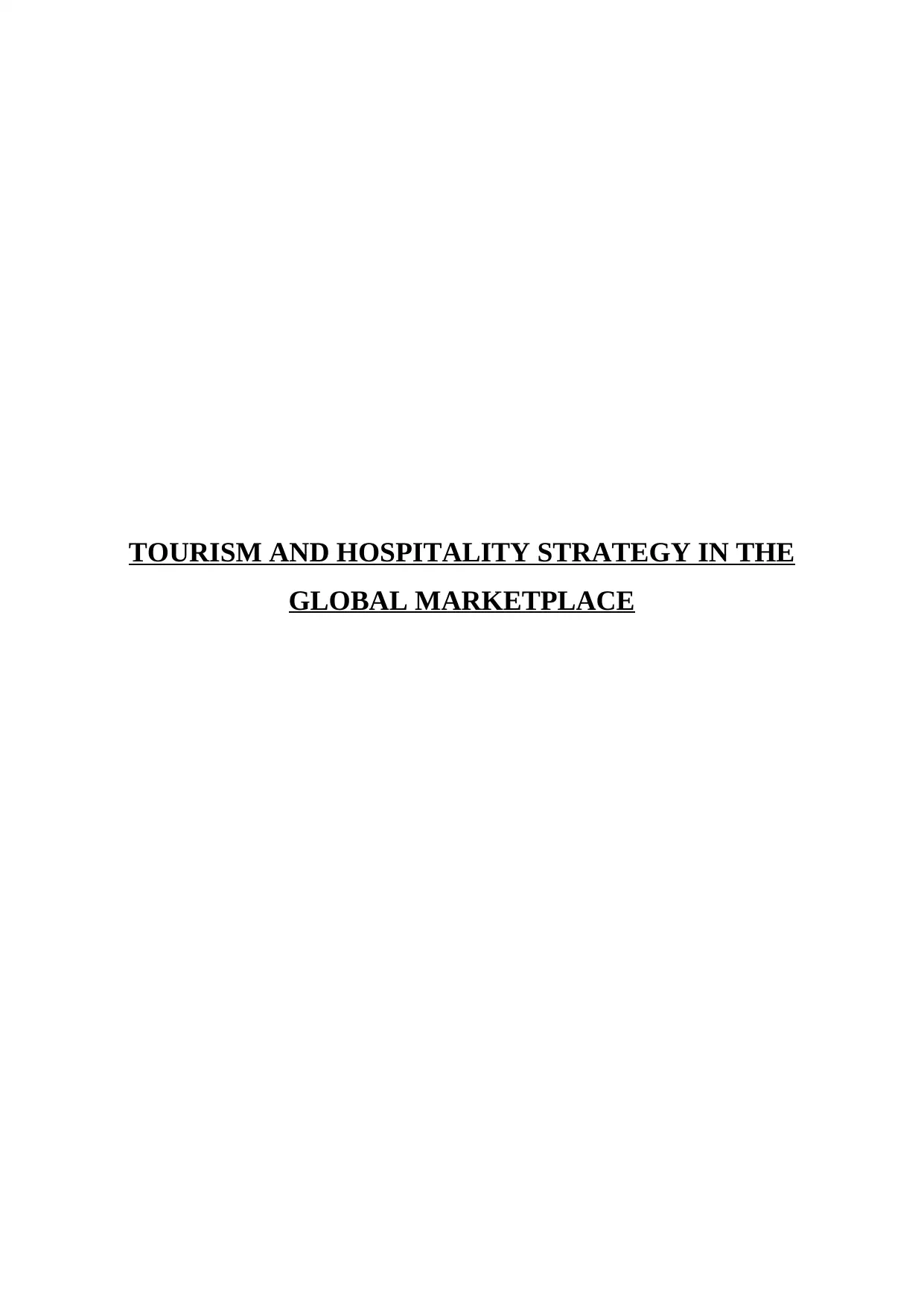
TOURISM AND HOSPITALITY STRATEGY IN THE
GLOBAL MARKETPLACE
GLOBAL MARKETPLACE
Secure Best Marks with AI Grader
Need help grading? Try our AI Grader for instant feedback on your assignments.
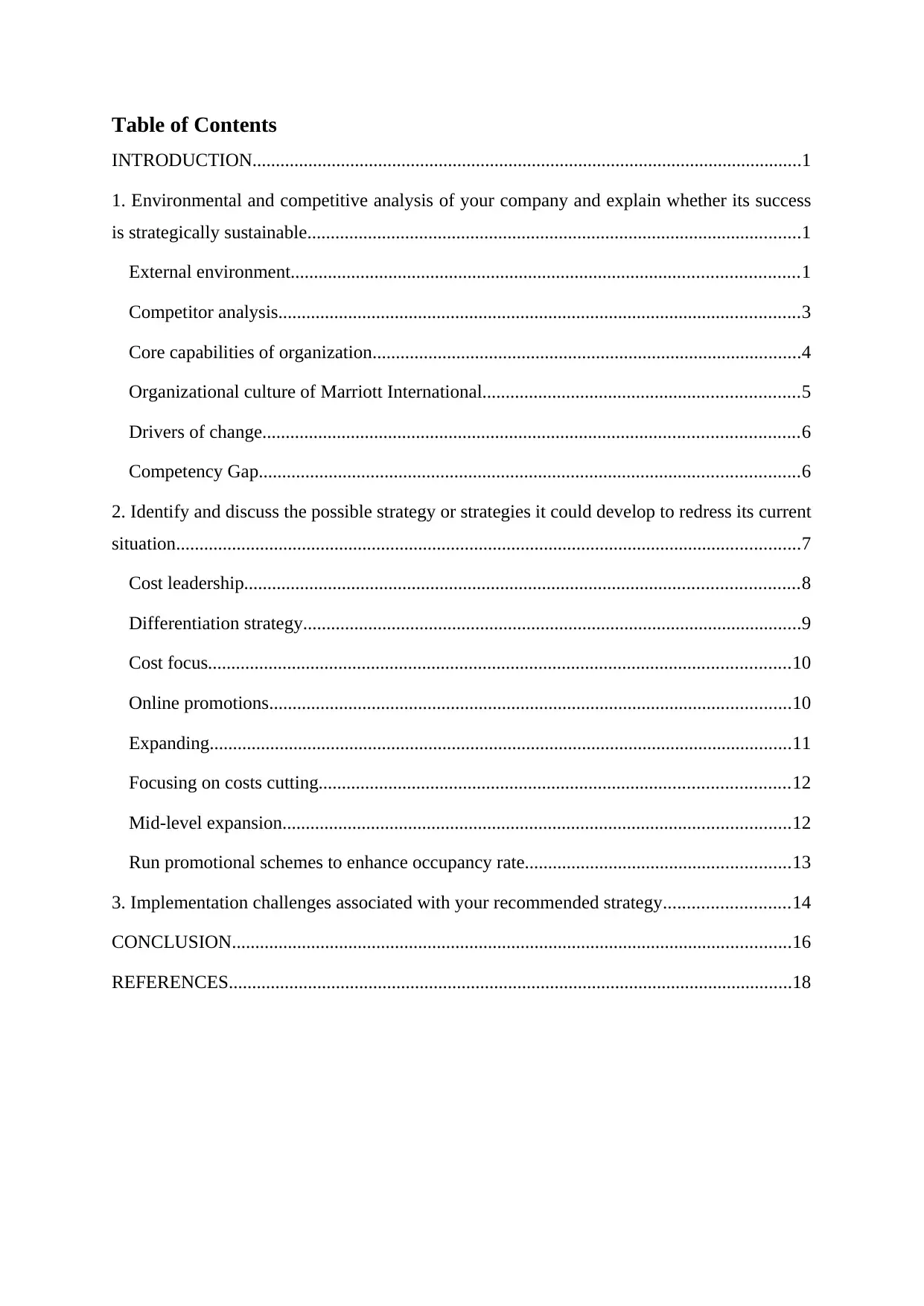
Table of Contents
INTRODUCTION......................................................................................................................1
1. Environmental and competitive analysis of your company and explain whether its success
is strategically sustainable..........................................................................................................1
External environment.............................................................................................................1
Competitor analysis................................................................................................................3
Core capabilities of organization............................................................................................4
Organizational culture of Marriott International....................................................................5
Drivers of change...................................................................................................................6
Competency Gap....................................................................................................................6
2. Identify and discuss the possible strategy or strategies it could develop to redress its current
situation......................................................................................................................................7
Cost leadership.......................................................................................................................8
Differentiation strategy...........................................................................................................9
Cost focus.............................................................................................................................10
Online promotions................................................................................................................10
Expanding.............................................................................................................................11
Focusing on costs cutting.....................................................................................................12
Mid-level expansion.............................................................................................................12
Run promotional schemes to enhance occupancy rate.........................................................13
3. Implementation challenges associated with your recommended strategy...........................14
CONCLUSION........................................................................................................................16
REFERENCES.........................................................................................................................18
INTRODUCTION......................................................................................................................1
1. Environmental and competitive analysis of your company and explain whether its success
is strategically sustainable..........................................................................................................1
External environment.............................................................................................................1
Competitor analysis................................................................................................................3
Core capabilities of organization............................................................................................4
Organizational culture of Marriott International....................................................................5
Drivers of change...................................................................................................................6
Competency Gap....................................................................................................................6
2. Identify and discuss the possible strategy or strategies it could develop to redress its current
situation......................................................................................................................................7
Cost leadership.......................................................................................................................8
Differentiation strategy...........................................................................................................9
Cost focus.............................................................................................................................10
Online promotions................................................................................................................10
Expanding.............................................................................................................................11
Focusing on costs cutting.....................................................................................................12
Mid-level expansion.............................................................................................................12
Run promotional schemes to enhance occupancy rate.........................................................13
3. Implementation challenges associated with your recommended strategy...........................14
CONCLUSION........................................................................................................................16
REFERENCES.........................................................................................................................18
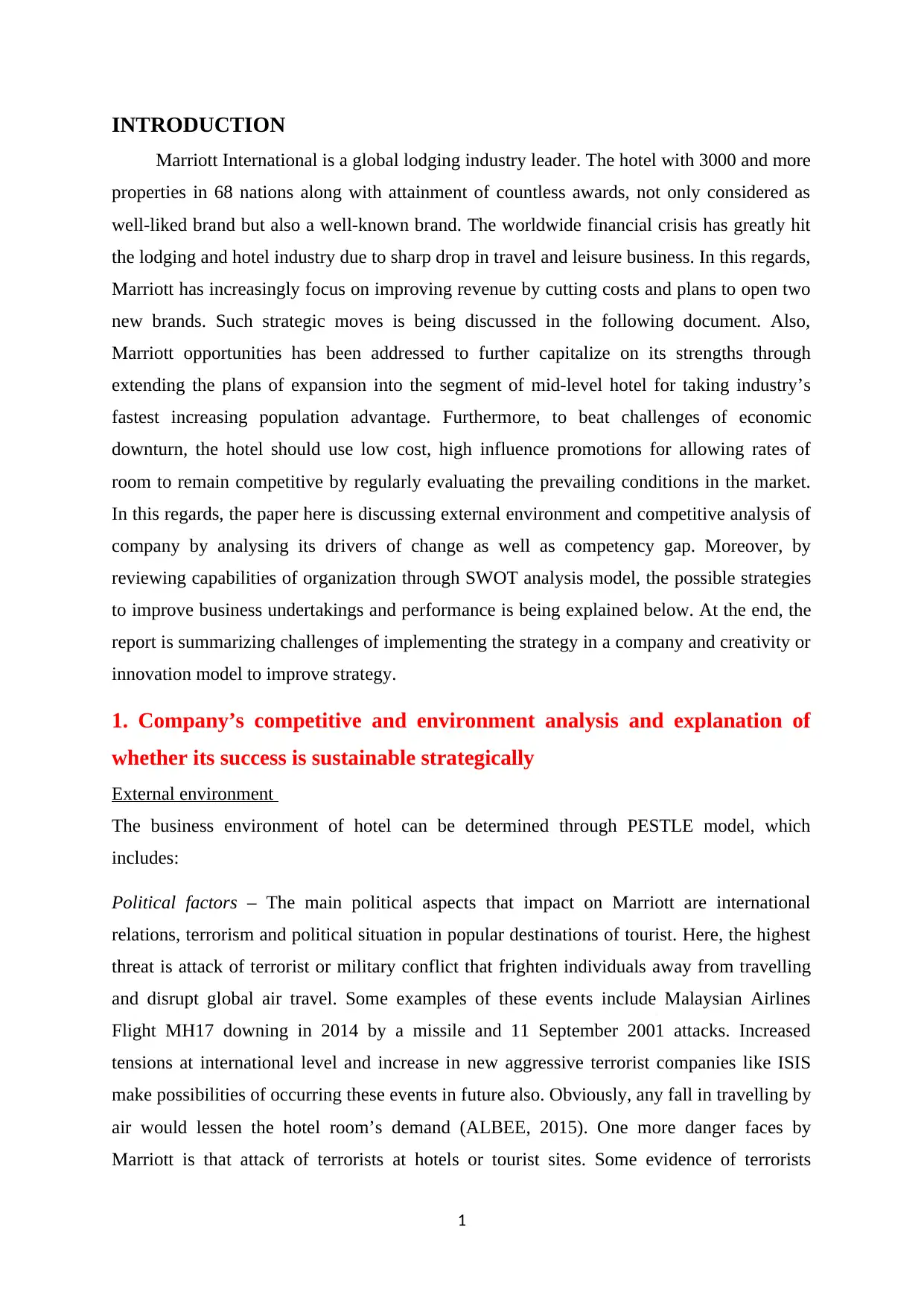
INTRODUCTION
Marriott International is a global lodging industry leader. The hotel with 3000 and more
properties in 68 nations along with attainment of countless awards, not only considered as
well-liked brand but also a well-known brand. The worldwide financial crisis has greatly hit
the lodging and hotel industry due to sharp drop in travel and leisure business. In this regards,
Marriott has increasingly focus on improving revenue by cutting costs and plans to open two
new brands. Such strategic moves is being discussed in the following document. Also,
Marriott opportunities has been addressed to further capitalize on its strengths through
extending the plans of expansion into the segment of mid-level hotel for taking industry’s
fastest increasing population advantage. Furthermore, to beat challenges of economic
downturn, the hotel should use low cost, high influence promotions for allowing rates of
room to remain competitive by regularly evaluating the prevailing conditions in the market.
In this regards, the paper here is discussing external environment and competitive analysis of
company by analysing its drivers of change as well as competency gap. Moreover, by
reviewing capabilities of organization through SWOT analysis model, the possible strategies
to improve business undertakings and performance is being explained below. At the end, the
report is summarizing challenges of implementing the strategy in a company and creativity or
innovation model to improve strategy.
1. Company’s competitive and environment analysis and explanation of
whether its success is sustainable strategically
External environment
The business environment of hotel can be determined through PESTLE model, which
includes:
Political factors – The main political aspects that impact on Marriott are international
relations, terrorism and political situation in popular destinations of tourist. Here, the highest
threat is attack of terrorist or military conflict that frighten individuals away from travelling
and disrupt global air travel. Some examples of these events include Malaysian Airlines
Flight MH17 downing in 2014 by a missile and 11 September 2001 attacks. Increased
tensions at international level and increase in new aggressive terrorist companies like ISIS
make possibilities of occurring these events in future also. Obviously, any fall in travelling by
air would lessen the hotel room’s demand (ALBEE, 2015). One more danger faces by
Marriott is that attack of terrorists at hotels or tourist sites. Some evidence of terrorists
1
Marriott International is a global lodging industry leader. The hotel with 3000 and more
properties in 68 nations along with attainment of countless awards, not only considered as
well-liked brand but also a well-known brand. The worldwide financial crisis has greatly hit
the lodging and hotel industry due to sharp drop in travel and leisure business. In this regards,
Marriott has increasingly focus on improving revenue by cutting costs and plans to open two
new brands. Such strategic moves is being discussed in the following document. Also,
Marriott opportunities has been addressed to further capitalize on its strengths through
extending the plans of expansion into the segment of mid-level hotel for taking industry’s
fastest increasing population advantage. Furthermore, to beat challenges of economic
downturn, the hotel should use low cost, high influence promotions for allowing rates of
room to remain competitive by regularly evaluating the prevailing conditions in the market.
In this regards, the paper here is discussing external environment and competitive analysis of
company by analysing its drivers of change as well as competency gap. Moreover, by
reviewing capabilities of organization through SWOT analysis model, the possible strategies
to improve business undertakings and performance is being explained below. At the end, the
report is summarizing challenges of implementing the strategy in a company and creativity or
innovation model to improve strategy.
1. Company’s competitive and environment analysis and explanation of
whether its success is sustainable strategically
External environment
The business environment of hotel can be determined through PESTLE model, which
includes:
Political factors – The main political aspects that impact on Marriott are international
relations, terrorism and political situation in popular destinations of tourist. Here, the highest
threat is attack of terrorist or military conflict that frighten individuals away from travelling
and disrupt global air travel. Some examples of these events include Malaysian Airlines
Flight MH17 downing in 2014 by a missile and 11 September 2001 attacks. Increased
tensions at international level and increase in new aggressive terrorist companies like ISIS
make possibilities of occurring these events in future also. Obviously, any fall in travelling by
air would lessen the hotel room’s demand (ALBEE, 2015). One more danger faces by
Marriott is that attack of terrorists at hotels or tourist sites. Some evidence of terrorists
1
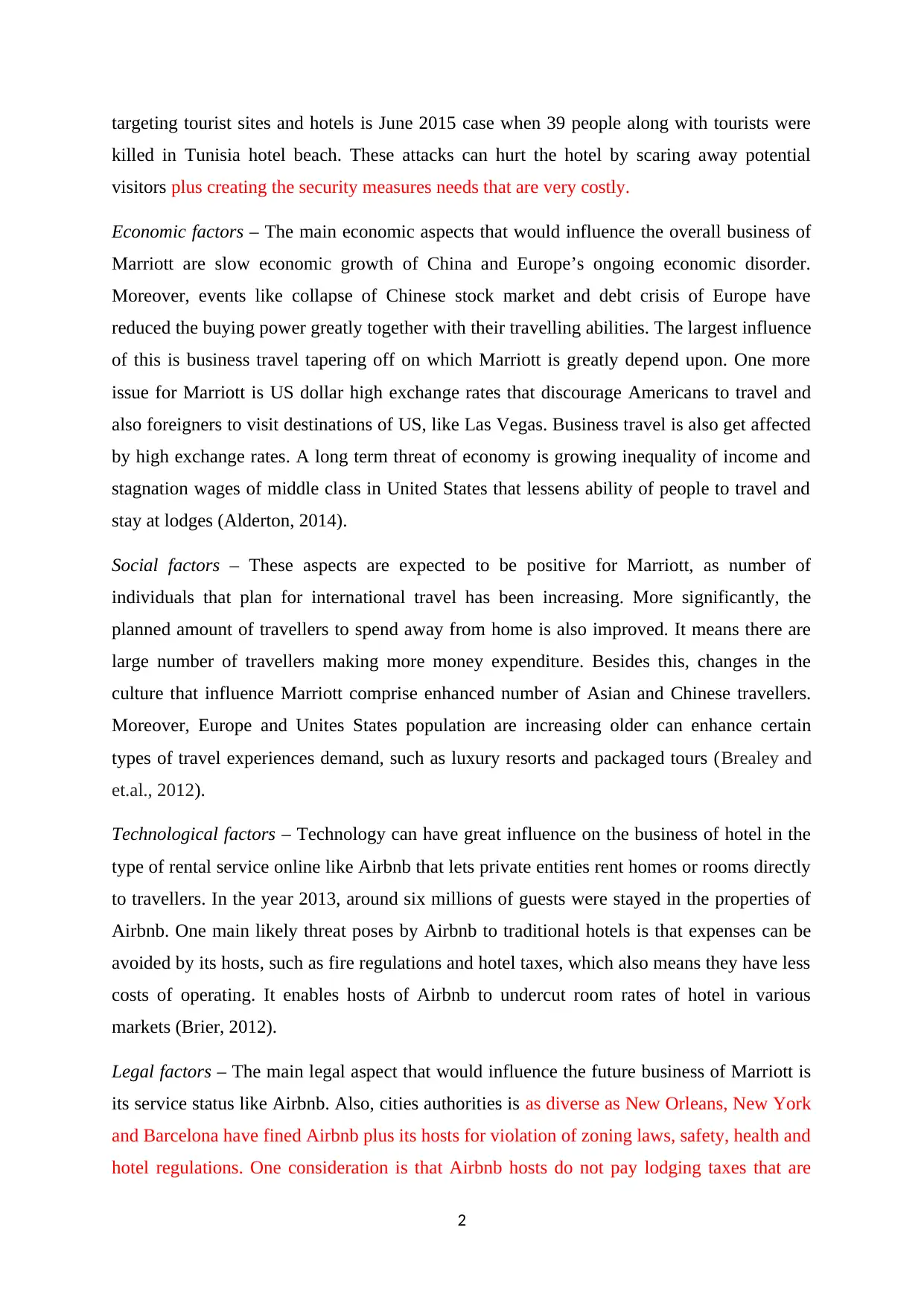
targeting tourist sites and hotels is June 2015 case when 39 people along with tourists were
killed in Tunisia hotel beach. These attacks can hurt the hotel by scaring away potential
visitors plus creating the security measures needs that are very costly.
Economic factors – The main economic aspects that would influence the overall business of
Marriott are slow economic growth of China and Europe’s ongoing economic disorder.
Moreover, events like collapse of Chinese stock market and debt crisis of Europe have
reduced the buying power greatly together with their travelling abilities. The largest influence
of this is business travel tapering off on which Marriott is greatly depend upon. One more
issue for Marriott is US dollar high exchange rates that discourage Americans to travel and
also foreigners to visit destinations of US, like Las Vegas. Business travel is also get affected
by high exchange rates. A long term threat of economy is growing inequality of income and
stagnation wages of middle class in United States that lessens ability of people to travel and
stay at lodges (Alderton, 2014).
Social factors – These aspects are expected to be positive for Marriott, as number of
individuals that plan for international travel has been increasing. More significantly, the
planned amount of travellers to spend away from home is also improved. It means there are
large number of travellers making more money expenditure. Besides this, changes in the
culture that influence Marriott comprise enhanced number of Asian and Chinese travellers.
Moreover, Europe and Unites States population are increasing older can enhance certain
types of travel experiences demand, such as luxury resorts and packaged tours (Brealey and
et.al., 2012).
Technological factors – Technology can have great influence on the business of hotel in the
type of rental service online like Airbnb that lets private entities rent homes or rooms directly
to travellers. In the year 2013, around six millions of guests were stayed in the properties of
Airbnb. One main likely threat poses by Airbnb to traditional hotels is that expenses can be
avoided by its hosts, such as fire regulations and hotel taxes, which also means they have less
costs of operating. It enables hosts of Airbnb to undercut room rates of hotel in various
markets (Brier, 2012).
Legal factors – The main legal aspect that would influence the future business of Marriott is
its service status like Airbnb. Also, cities authorities is as diverse as New Orleans, New York
and Barcelona have fined Airbnb plus its hosts for violation of zoning laws, safety, health and
hotel regulations. One consideration is that Airbnb hosts do not pay lodging taxes that are
2
killed in Tunisia hotel beach. These attacks can hurt the hotel by scaring away potential
visitors plus creating the security measures needs that are very costly.
Economic factors – The main economic aspects that would influence the overall business of
Marriott are slow economic growth of China and Europe’s ongoing economic disorder.
Moreover, events like collapse of Chinese stock market and debt crisis of Europe have
reduced the buying power greatly together with their travelling abilities. The largest influence
of this is business travel tapering off on which Marriott is greatly depend upon. One more
issue for Marriott is US dollar high exchange rates that discourage Americans to travel and
also foreigners to visit destinations of US, like Las Vegas. Business travel is also get affected
by high exchange rates. A long term threat of economy is growing inequality of income and
stagnation wages of middle class in United States that lessens ability of people to travel and
stay at lodges (Alderton, 2014).
Social factors – These aspects are expected to be positive for Marriott, as number of
individuals that plan for international travel has been increasing. More significantly, the
planned amount of travellers to spend away from home is also improved. It means there are
large number of travellers making more money expenditure. Besides this, changes in the
culture that influence Marriott comprise enhanced number of Asian and Chinese travellers.
Moreover, Europe and Unites States population are increasing older can enhance certain
types of travel experiences demand, such as luxury resorts and packaged tours (Brealey and
et.al., 2012).
Technological factors – Technology can have great influence on the business of hotel in the
type of rental service online like Airbnb that lets private entities rent homes or rooms directly
to travellers. In the year 2013, around six millions of guests were stayed in the properties of
Airbnb. One main likely threat poses by Airbnb to traditional hotels is that expenses can be
avoided by its hosts, such as fire regulations and hotel taxes, which also means they have less
costs of operating. It enables hosts of Airbnb to undercut room rates of hotel in various
markets (Brier, 2012).
Legal factors – The main legal aspect that would influence the future business of Marriott is
its service status like Airbnb. Also, cities authorities is as diverse as New Orleans, New York
and Barcelona have fined Airbnb plus its hosts for violation of zoning laws, safety, health and
hotel regulations. One consideration is that Airbnb hosts do not pay lodging taxes that are
2
Secure Best Marks with AI Grader
Need help grading? Try our AI Grader for instant feedback on your assignments.
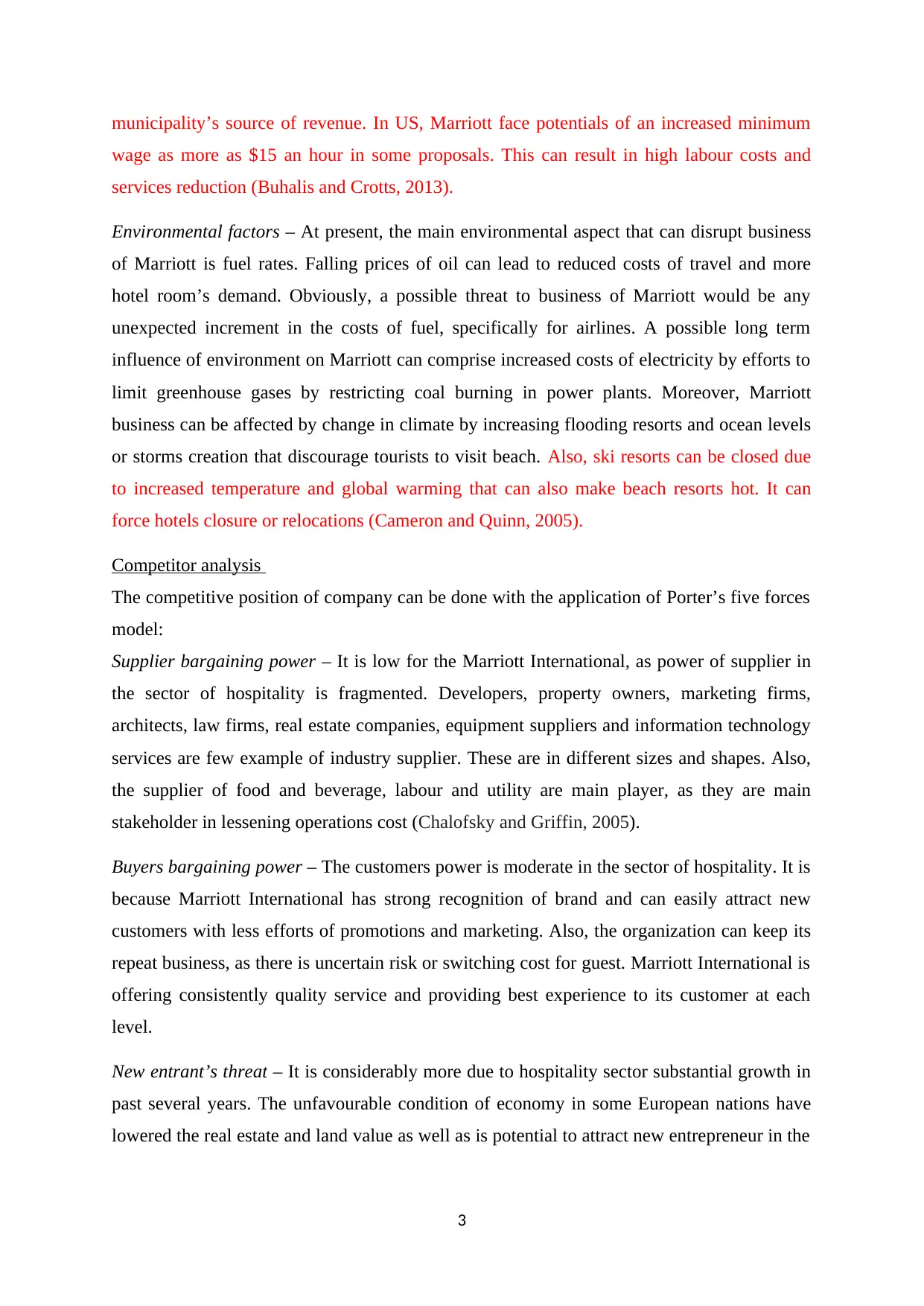
municipality’s source of revenue. In US, Marriott face potentials of an increased minimum
wage as more as $15 an hour in some proposals. This can result in high labour costs and
services reduction (Buhalis and Crotts, 2013).
Environmental factors – At present, the main environmental aspect that can disrupt business
of Marriott is fuel rates. Falling prices of oil can lead to reduced costs of travel and more
hotel room’s demand. Obviously, a possible threat to business of Marriott would be any
unexpected increment in the costs of fuel, specifically for airlines. A possible long term
influence of environment on Marriott can comprise increased costs of electricity by efforts to
limit greenhouse gases by restricting coal burning in power plants. Moreover, Marriott
business can be affected by change in climate by increasing flooding resorts and ocean levels
or storms creation that discourage tourists to visit beach. Also, ski resorts can be closed due
to increased temperature and global warming that can also make beach resorts hot. It can
force hotels closure or relocations (Cameron and Quinn, 2005).
Competitor analysis
The competitive position of company can be done with the application of Porter’s five forces
model:
Supplier bargaining power – It is low for the Marriott International, as power of supplier in
the sector of hospitality is fragmented. Developers, property owners, marketing firms,
architects, law firms, real estate companies, equipment suppliers and information technology
services are few example of industry supplier. These are in different sizes and shapes. Also,
the supplier of food and beverage, labour and utility are main player, as they are main
stakeholder in lessening operations cost (Chalofsky and Griffin, 2005).
Buyers bargaining power – The customers power is moderate in the sector of hospitality. It is
because Marriott International has strong recognition of brand and can easily attract new
customers with less efforts of promotions and marketing. Also, the organization can keep its
repeat business, as there is uncertain risk or switching cost for guest. Marriott International is
offering consistently quality service and providing best experience to its customer at each
level.
New entrant’s threat – It is considerably more due to hospitality sector substantial growth in
past several years. The unfavourable condition of economy in some European nations have
lowered the real estate and land value as well as is potential to attract new entrepreneur in the
3
wage as more as $15 an hour in some proposals. This can result in high labour costs and
services reduction (Buhalis and Crotts, 2013).
Environmental factors – At present, the main environmental aspect that can disrupt business
of Marriott is fuel rates. Falling prices of oil can lead to reduced costs of travel and more
hotel room’s demand. Obviously, a possible threat to business of Marriott would be any
unexpected increment in the costs of fuel, specifically for airlines. A possible long term
influence of environment on Marriott can comprise increased costs of electricity by efforts to
limit greenhouse gases by restricting coal burning in power plants. Moreover, Marriott
business can be affected by change in climate by increasing flooding resorts and ocean levels
or storms creation that discourage tourists to visit beach. Also, ski resorts can be closed due
to increased temperature and global warming that can also make beach resorts hot. It can
force hotels closure or relocations (Cameron and Quinn, 2005).
Competitor analysis
The competitive position of company can be done with the application of Porter’s five forces
model:
Supplier bargaining power – It is low for the Marriott International, as power of supplier in
the sector of hospitality is fragmented. Developers, property owners, marketing firms,
architects, law firms, real estate companies, equipment suppliers and information technology
services are few example of industry supplier. These are in different sizes and shapes. Also,
the supplier of food and beverage, labour and utility are main player, as they are main
stakeholder in lessening operations cost (Chalofsky and Griffin, 2005).
Buyers bargaining power – The customers power is moderate in the sector of hospitality. It is
because Marriott International has strong recognition of brand and can easily attract new
customers with less efforts of promotions and marketing. Also, the organization can keep its
repeat business, as there is uncertain risk or switching cost for guest. Marriott International is
offering consistently quality service and providing best experience to its customer at each
level.
New entrant’s threat – It is considerably more due to hospitality sector substantial growth in
past several years. The unfavourable condition of economy in some European nations have
lowered the real estate and land value as well as is potential to attract new entrepreneur in the
3
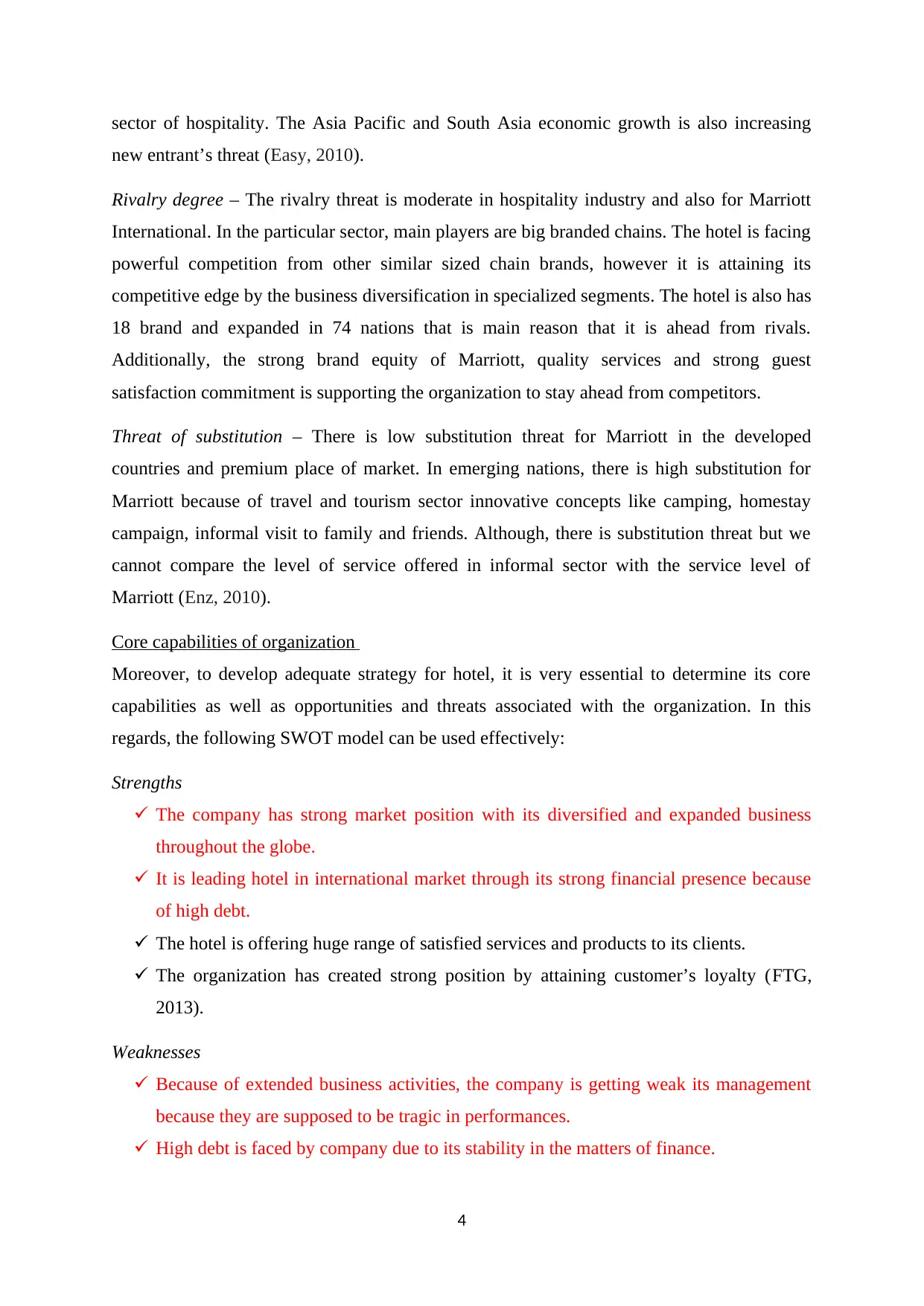
sector of hospitality. The Asia Pacific and South Asia economic growth is also increasing
new entrant’s threat (Easy, 2010).
Rivalry degree – The rivalry threat is moderate in hospitality industry and also for Marriott
International. In the particular sector, main players are big branded chains. The hotel is facing
powerful competition from other similar sized chain brands, however it is attaining its
competitive edge by the business diversification in specialized segments. The hotel is also has
18 brand and expanded in 74 nations that is main reason that it is ahead from rivals.
Additionally, the strong brand equity of Marriott, quality services and strong guest
satisfaction commitment is supporting the organization to stay ahead from competitors.
Threat of substitution – There is low substitution threat for Marriott in the developed
countries and premium place of market. In emerging nations, there is high substitution for
Marriott because of travel and tourism sector innovative concepts like camping, homestay
campaign, informal visit to family and friends. Although, there is substitution threat but we
cannot compare the level of service offered in informal sector with the service level of
Marriott (Enz, 2010).
Core capabilities of organization
Moreover, to develop adequate strategy for hotel, it is very essential to determine its core
capabilities as well as opportunities and threats associated with the organization. In this
regards, the following SWOT model can be used effectively:
Strengths
The company has strong market position with its diversified and expanded business
throughout the globe.
It is leading hotel in international market through its strong financial presence because
of high debt.
The hotel is offering huge range of satisfied services and products to its clients.
The organization has created strong position by attaining customer’s loyalty (FTG,
2013).
Weaknesses
Because of extended business activities, the company is getting weak its management
because they are supposed to be tragic in performances.
High debt is faced by company due to its stability in the matters of finance.
4
new entrant’s threat (Easy, 2010).
Rivalry degree – The rivalry threat is moderate in hospitality industry and also for Marriott
International. In the particular sector, main players are big branded chains. The hotel is facing
powerful competition from other similar sized chain brands, however it is attaining its
competitive edge by the business diversification in specialized segments. The hotel is also has
18 brand and expanded in 74 nations that is main reason that it is ahead from rivals.
Additionally, the strong brand equity of Marriott, quality services and strong guest
satisfaction commitment is supporting the organization to stay ahead from competitors.
Threat of substitution – There is low substitution threat for Marriott in the developed
countries and premium place of market. In emerging nations, there is high substitution for
Marriott because of travel and tourism sector innovative concepts like camping, homestay
campaign, informal visit to family and friends. Although, there is substitution threat but we
cannot compare the level of service offered in informal sector with the service level of
Marriott (Enz, 2010).
Core capabilities of organization
Moreover, to develop adequate strategy for hotel, it is very essential to determine its core
capabilities as well as opportunities and threats associated with the organization. In this
regards, the following SWOT model can be used effectively:
Strengths
The company has strong market position with its diversified and expanded business
throughout the globe.
It is leading hotel in international market through its strong financial presence because
of high debt.
The hotel is offering huge range of satisfied services and products to its clients.
The organization has created strong position by attaining customer’s loyalty (FTG,
2013).
Weaknesses
Because of extended business activities, the company is getting weak its management
because they are supposed to be tragic in performances.
High debt is faced by company due to its stability in the matters of finance.
4
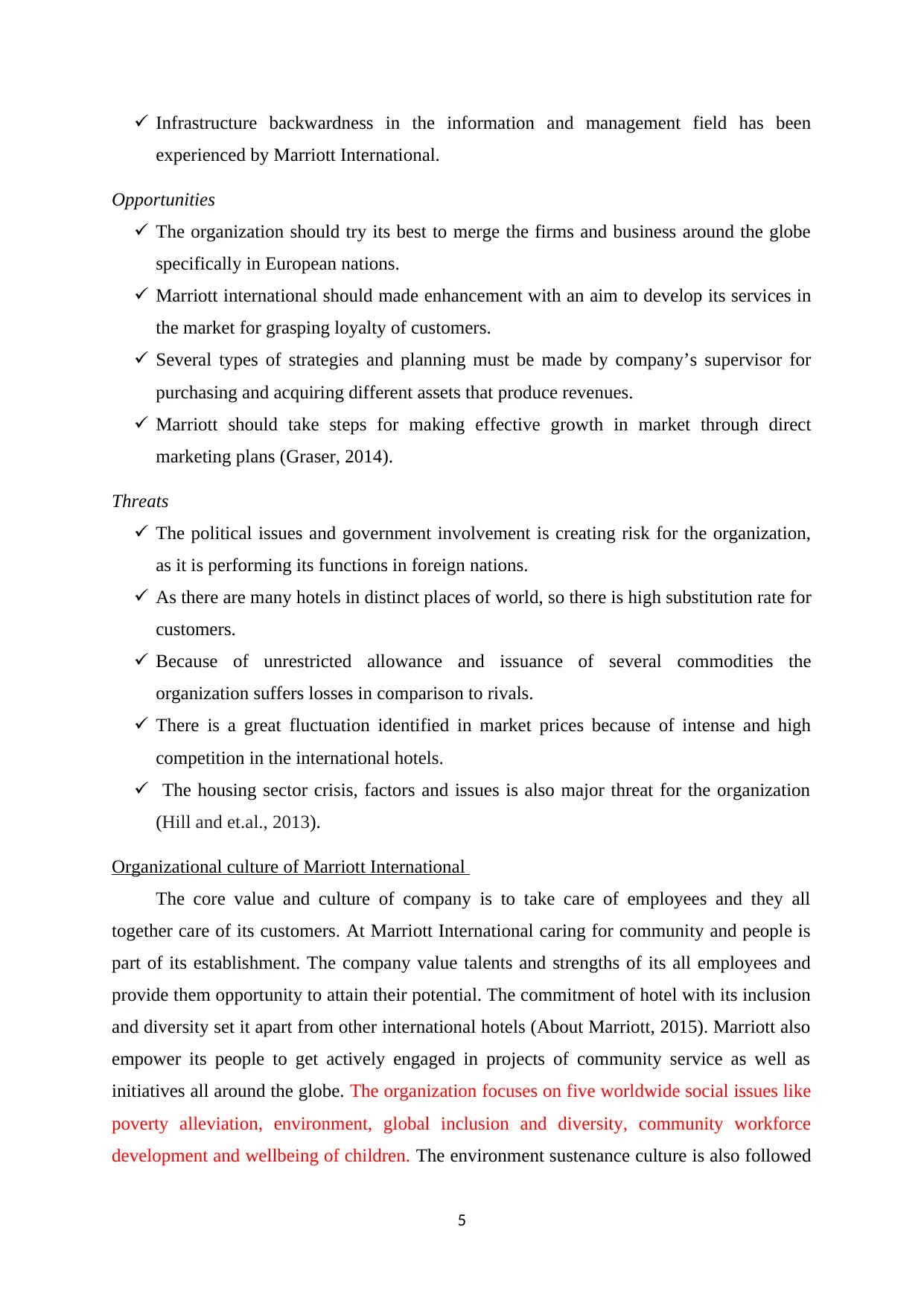
Infrastructure backwardness in the information and management field has been
experienced by Marriott International.
Opportunities
The organization should try its best to merge the firms and business around the globe
specifically in European nations.
Marriott international should made enhancement with an aim to develop its services in
the market for grasping loyalty of customers.
Several types of strategies and planning must be made by company’s supervisor for
purchasing and acquiring different assets that produce revenues.
Marriott should take steps for making effective growth in market through direct
marketing plans (Graser, 2014).
Threats
The political issues and government involvement is creating risk for the organization,
as it is performing its functions in foreign nations.
As there are many hotels in distinct places of world, so there is high substitution rate for
customers.
Because of unrestricted allowance and issuance of several commodities the
organization suffers losses in comparison to rivals.
There is a great fluctuation identified in market prices because of intense and high
competition in the international hotels.
The housing sector crisis, factors and issues is also major threat for the organization
(Hill and et.al., 2013).
Organizational culture of Marriott International
The core value and culture of company is to take care of employees and they all
together care of its customers. At Marriott International caring for community and people is
part of its establishment. The company value talents and strengths of its all employees and
provide them opportunity to attain their potential. The commitment of hotel with its inclusion
and diversity set it apart from other international hotels (About Marriott, 2015). Marriott also
empower its people to get actively engaged in projects of community service as well as
initiatives all around the globe. The organization focuses on five worldwide social issues like
poverty alleviation, environment, global inclusion and diversity, community workforce
development and wellbeing of children. The environment sustenance culture is also followed
5
experienced by Marriott International.
Opportunities
The organization should try its best to merge the firms and business around the globe
specifically in European nations.
Marriott international should made enhancement with an aim to develop its services in
the market for grasping loyalty of customers.
Several types of strategies and planning must be made by company’s supervisor for
purchasing and acquiring different assets that produce revenues.
Marriott should take steps for making effective growth in market through direct
marketing plans (Graser, 2014).
Threats
The political issues and government involvement is creating risk for the organization,
as it is performing its functions in foreign nations.
As there are many hotels in distinct places of world, so there is high substitution rate for
customers.
Because of unrestricted allowance and issuance of several commodities the
organization suffers losses in comparison to rivals.
There is a great fluctuation identified in market prices because of intense and high
competition in the international hotels.
The housing sector crisis, factors and issues is also major threat for the organization
(Hill and et.al., 2013).
Organizational culture of Marriott International
The core value and culture of company is to take care of employees and they all
together care of its customers. At Marriott International caring for community and people is
part of its establishment. The company value talents and strengths of its all employees and
provide them opportunity to attain their potential. The commitment of hotel with its inclusion
and diversity set it apart from other international hotels (About Marriott, 2015). Marriott also
empower its people to get actively engaged in projects of community service as well as
initiatives all around the globe. The organization focuses on five worldwide social issues like
poverty alleviation, environment, global inclusion and diversity, community workforce
development and wellbeing of children. The environment sustenance culture is also followed
5
Paraphrase This Document
Need a fresh take? Get an instant paraphrase of this document with our AI Paraphraser
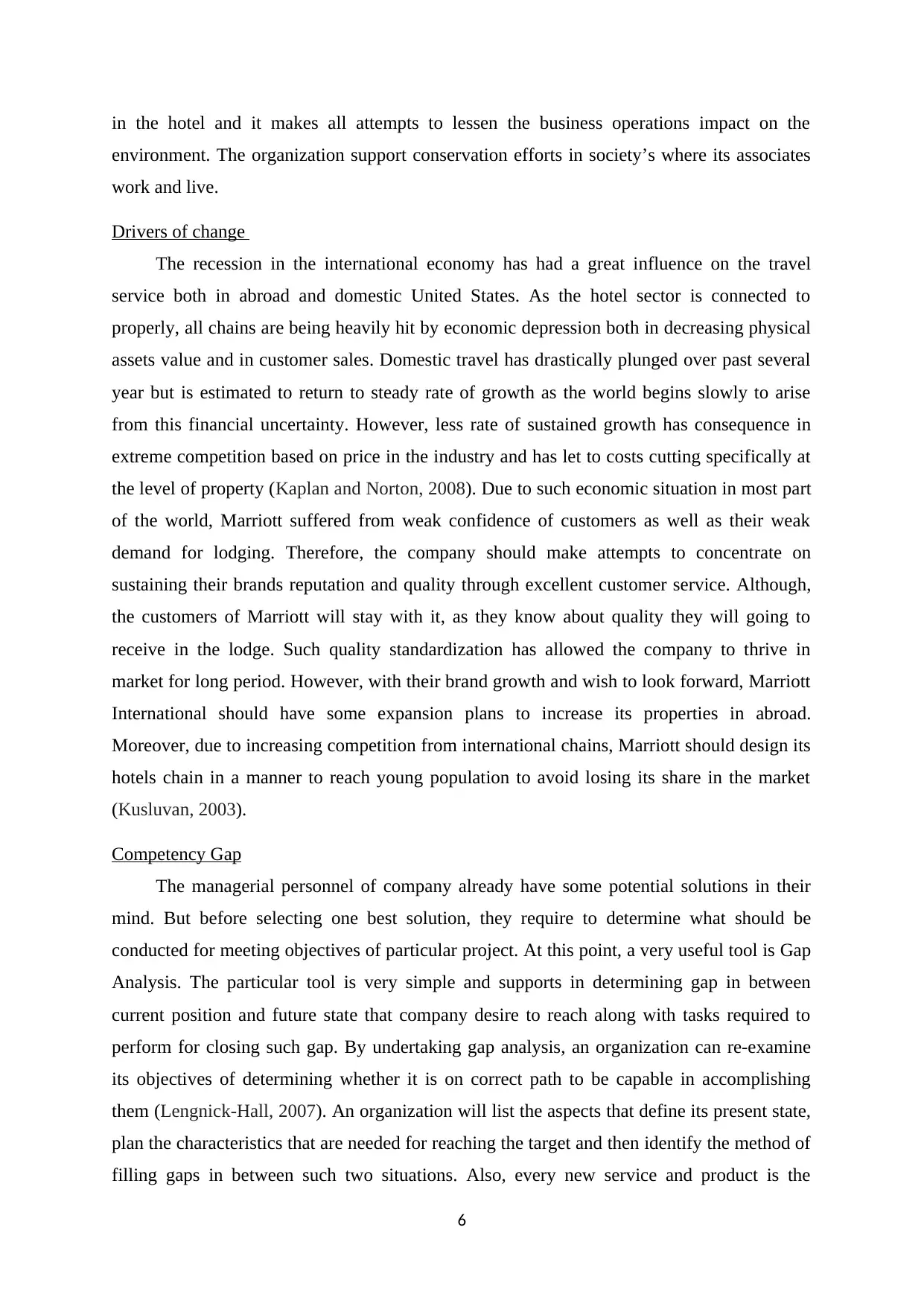
in the hotel and it makes all attempts to lessen the business operations impact on the
environment. The organization support conservation efforts in society’s where its associates
work and live.
Drivers of change
The recession in the international economy has had a great influence on the travel
service both in abroad and domestic United States. As the hotel sector is connected to
properly, all chains are being heavily hit by economic depression both in decreasing physical
assets value and in customer sales. Domestic travel has drastically plunged over past several
year but is estimated to return to steady rate of growth as the world begins slowly to arise
from this financial uncertainty. However, less rate of sustained growth has consequence in
extreme competition based on price in the industry and has let to costs cutting specifically at
the level of property (Kaplan and Norton, 2008). Due to such economic situation in most part
of the world, Marriott suffered from weak confidence of customers as well as their weak
demand for lodging. Therefore, the company should make attempts to concentrate on
sustaining their brands reputation and quality through excellent customer service. Although,
the customers of Marriott will stay with it, as they know about quality they will going to
receive in the lodge. Such quality standardization has allowed the company to thrive in
market for long period. However, with their brand growth and wish to look forward, Marriott
International should have some expansion plans to increase its properties in abroad.
Moreover, due to increasing competition from international chains, Marriott should design its
hotels chain in a manner to reach young population to avoid losing its share in the market
(Kusluvan, 2003).
Competency Gap
The managerial personnel of company already have some potential solutions in their
mind. But before selecting one best solution, they require to determine what should be
conducted for meeting objectives of particular project. At this point, a very useful tool is Gap
Analysis. The particular tool is very simple and supports in determining gap in between
current position and future state that company desire to reach along with tasks required to
perform for closing such gap. By undertaking gap analysis, an organization can re-examine
its objectives of determining whether it is on correct path to be capable in accomplishing
them (Lengnick-Hall, 2007). An organization will list the aspects that define its present state,
plan the characteristics that are needed for reaching the target and then identify the method of
filling gaps in between such two situations. Also, every new service and product is the
6
environment. The organization support conservation efforts in society’s where its associates
work and live.
Drivers of change
The recession in the international economy has had a great influence on the travel
service both in abroad and domestic United States. As the hotel sector is connected to
properly, all chains are being heavily hit by economic depression both in decreasing physical
assets value and in customer sales. Domestic travel has drastically plunged over past several
year but is estimated to return to steady rate of growth as the world begins slowly to arise
from this financial uncertainty. However, less rate of sustained growth has consequence in
extreme competition based on price in the industry and has let to costs cutting specifically at
the level of property (Kaplan and Norton, 2008). Due to such economic situation in most part
of the world, Marriott suffered from weak confidence of customers as well as their weak
demand for lodging. Therefore, the company should make attempts to concentrate on
sustaining their brands reputation and quality through excellent customer service. Although,
the customers of Marriott will stay with it, as they know about quality they will going to
receive in the lodge. Such quality standardization has allowed the company to thrive in
market for long period. However, with their brand growth and wish to look forward, Marriott
International should have some expansion plans to increase its properties in abroad.
Moreover, due to increasing competition from international chains, Marriott should design its
hotels chain in a manner to reach young population to avoid losing its share in the market
(Kusluvan, 2003).
Competency Gap
The managerial personnel of company already have some potential solutions in their
mind. But before selecting one best solution, they require to determine what should be
conducted for meeting objectives of particular project. At this point, a very useful tool is Gap
Analysis. The particular tool is very simple and supports in determining gap in between
current position and future state that company desire to reach along with tasks required to
perform for closing such gap. By undertaking gap analysis, an organization can re-examine
its objectives of determining whether it is on correct path to be capable in accomplishing
them (Lengnick-Hall, 2007). An organization will list the aspects that define its present state,
plan the characteristics that are needed for reaching the target and then identify the method of
filling gaps in between such two situations. Also, every new service and product is the
6
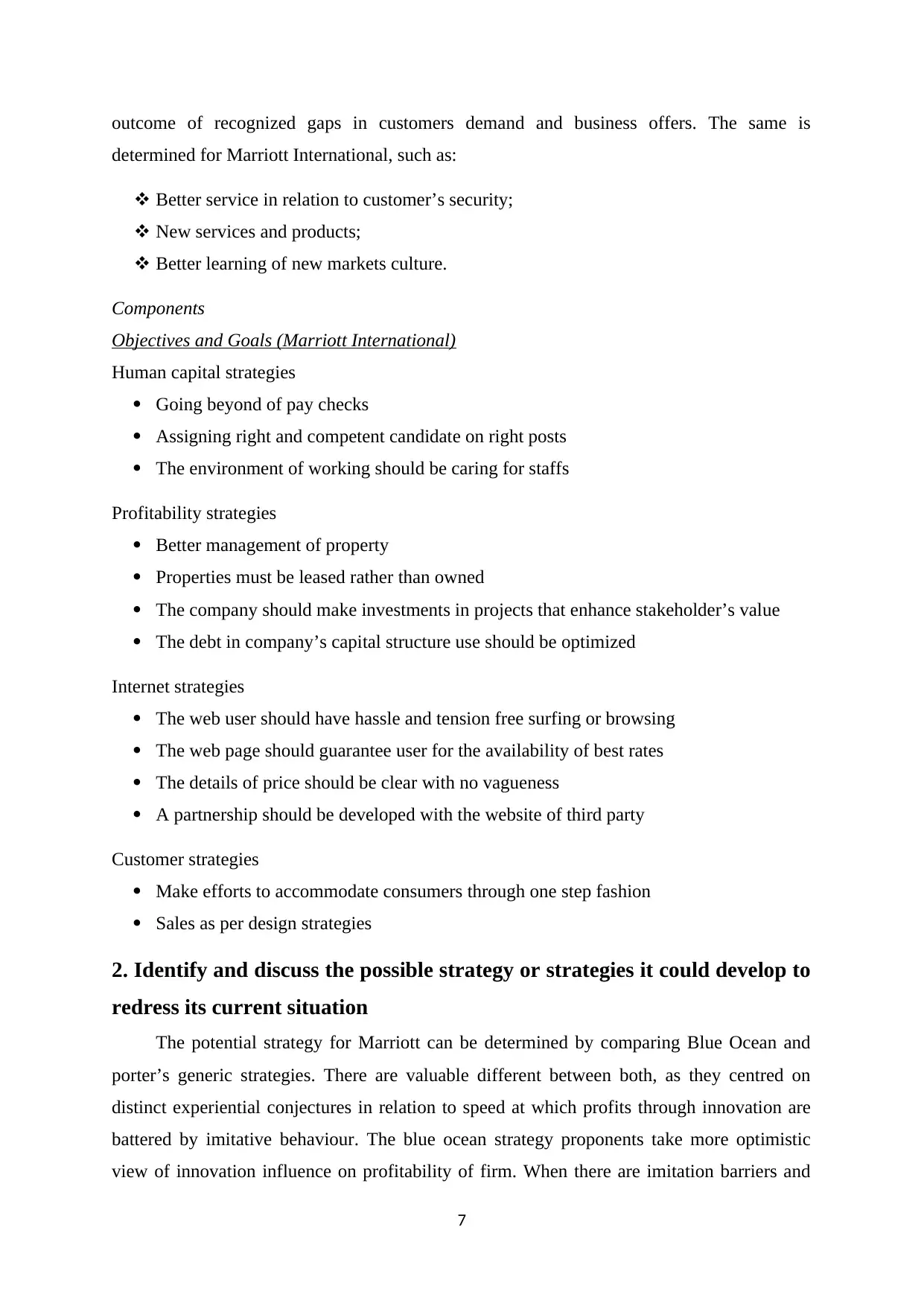
outcome of recognized gaps in customers demand and business offers. The same is
determined for Marriott International, such as:
Better service in relation to customer’s security;
New services and products;
Better learning of new markets culture.
Components
Objectives and Goals (Marriott International)
Human capital strategies
Going beyond of pay checks
Assigning right and competent candidate on right posts
The environment of working should be caring for staffs
Profitability strategies
Better management of property
Properties must be leased rather than owned
The company should make investments in projects that enhance stakeholder’s value
The debt in company’s capital structure use should be optimized
Internet strategies
The web user should have hassle and tension free surfing or browsing
The web page should guarantee user for the availability of best rates
The details of price should be clear with no vagueness
A partnership should be developed with the website of third party
Customer strategies
Make efforts to accommodate consumers through one step fashion
Sales as per design strategies
2. Identify and discuss the possible strategy or strategies it could develop to
redress its current situation
The potential strategy for Marriott can be determined by comparing Blue Ocean and
porter’s generic strategies. There are valuable different between both, as they centred on
distinct experiential conjectures in relation to speed at which profits through innovation are
battered by imitative behaviour. The blue ocean strategy proponents take more optimistic
view of innovation influence on profitability of firm. When there are imitation barriers and
7
determined for Marriott International, such as:
Better service in relation to customer’s security;
New services and products;
Better learning of new markets culture.
Components
Objectives and Goals (Marriott International)
Human capital strategies
Going beyond of pay checks
Assigning right and competent candidate on right posts
The environment of working should be caring for staffs
Profitability strategies
Better management of property
Properties must be leased rather than owned
The company should make investments in projects that enhance stakeholder’s value
The debt in company’s capital structure use should be optimized
Internet strategies
The web user should have hassle and tension free surfing or browsing
The web page should guarantee user for the availability of best rates
The details of price should be clear with no vagueness
A partnership should be developed with the website of third party
Customer strategies
Make efforts to accommodate consumers through one step fashion
Sales as per design strategies
2. Identify and discuss the possible strategy or strategies it could develop to
redress its current situation
The potential strategy for Marriott can be determined by comparing Blue Ocean and
porter’s generic strategies. There are valuable different between both, as they centred on
distinct experiential conjectures in relation to speed at which profits through innovation are
battered by imitative behaviour. The blue ocean strategy proponents take more optimistic
view of innovation influence on profitability of firm. When there are imitation barriers and
7
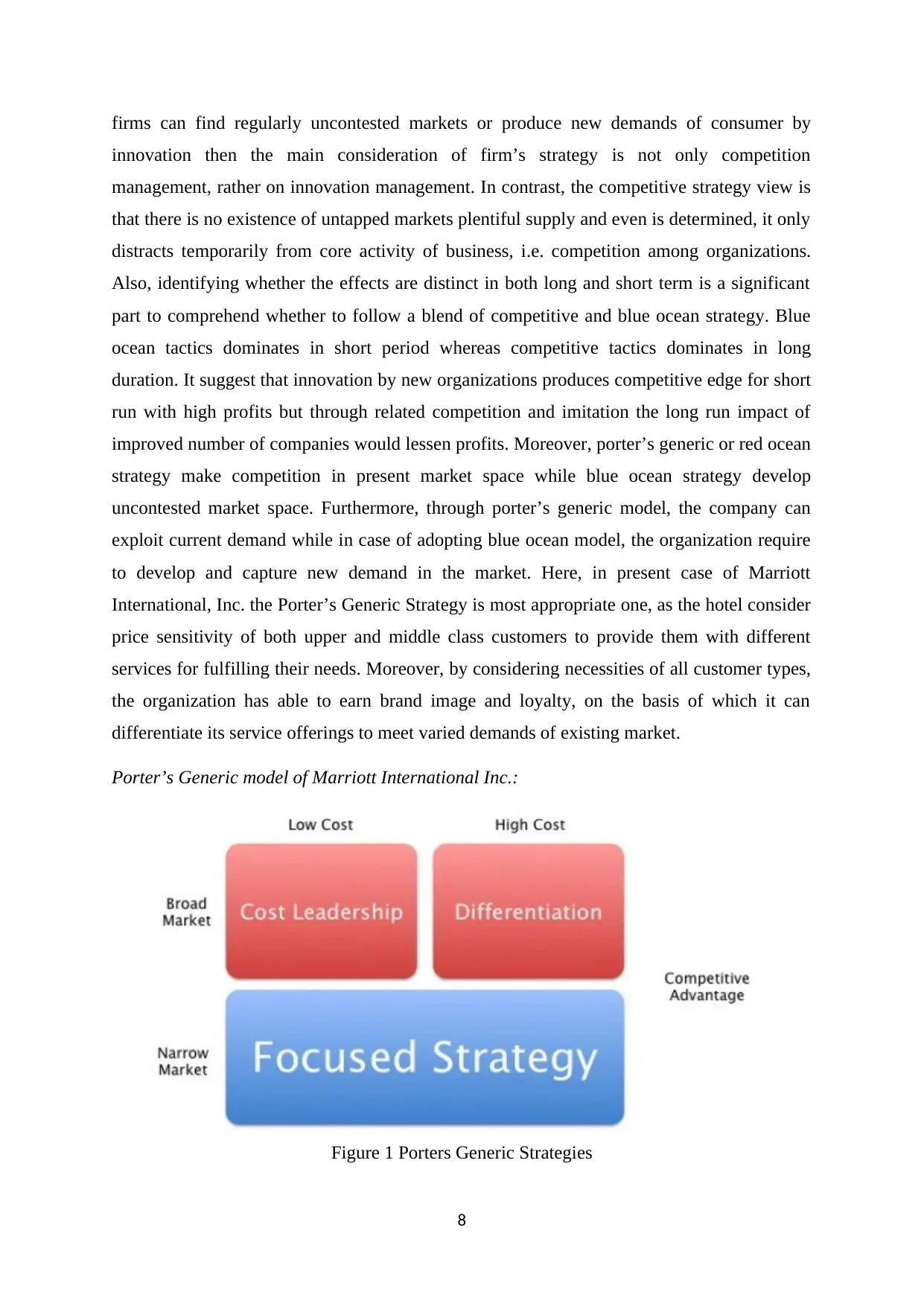
firms can find regularly uncontested markets or produce new demands of consumer by
innovation then the main consideration of firm’s strategy is not only competition
management, rather on innovation management. In contrast, the competitive strategy view is
that there is no existence of untapped markets plentiful supply and even is determined, it only
distracts temporarily from core activity of business, i.e. competition among organizations.
Also, identifying whether the effects are distinct in both long and short term is a significant
part to comprehend whether to follow a blend of competitive and blue ocean strategy. Blue
ocean tactics dominates in short period whereas competitive tactics dominates in long
duration. It suggest that innovation by new organizations produces competitive edge for short
run with high profits but through related competition and imitation the long run impact of
improved number of companies would lessen profits. Moreover, porter’s generic or red ocean
strategy make competition in present market space while blue ocean strategy develop
uncontested market space. Furthermore, through porter’s generic model, the company can
exploit current demand while in case of adopting blue ocean model, the organization require
to develop and capture new demand in the market. Here, in present case of Marriott
International, Inc. the Porter’s Generic Strategy is most appropriate one, as the hotel consider
price sensitivity of both upper and middle class customers to provide them with different
services for fulfilling their needs. Moreover, by considering necessities of all customer types,
the organization has able to earn brand image and loyalty, on the basis of which it can
differentiate its service offerings to meet varied demands of existing market.
Porter’s Generic model of Marriott International Inc.:
Figure 1 Porters Generic Strategies
8
innovation then the main consideration of firm’s strategy is not only competition
management, rather on innovation management. In contrast, the competitive strategy view is
that there is no existence of untapped markets plentiful supply and even is determined, it only
distracts temporarily from core activity of business, i.e. competition among organizations.
Also, identifying whether the effects are distinct in both long and short term is a significant
part to comprehend whether to follow a blend of competitive and blue ocean strategy. Blue
ocean tactics dominates in short period whereas competitive tactics dominates in long
duration. It suggest that innovation by new organizations produces competitive edge for short
run with high profits but through related competition and imitation the long run impact of
improved number of companies would lessen profits. Moreover, porter’s generic or red ocean
strategy make competition in present market space while blue ocean strategy develop
uncontested market space. Furthermore, through porter’s generic model, the company can
exploit current demand while in case of adopting blue ocean model, the organization require
to develop and capture new demand in the market. Here, in present case of Marriott
International, Inc. the Porter’s Generic Strategy is most appropriate one, as the hotel consider
price sensitivity of both upper and middle class customers to provide them with different
services for fulfilling their needs. Moreover, by considering necessities of all customer types,
the organization has able to earn brand image and loyalty, on the basis of which it can
differentiate its service offerings to meet varied demands of existing market.
Porter’s Generic model of Marriott International Inc.:
Figure 1 Porters Generic Strategies
8
Secure Best Marks with AI Grader
Need help grading? Try our AI Grader for instant feedback on your assignments.
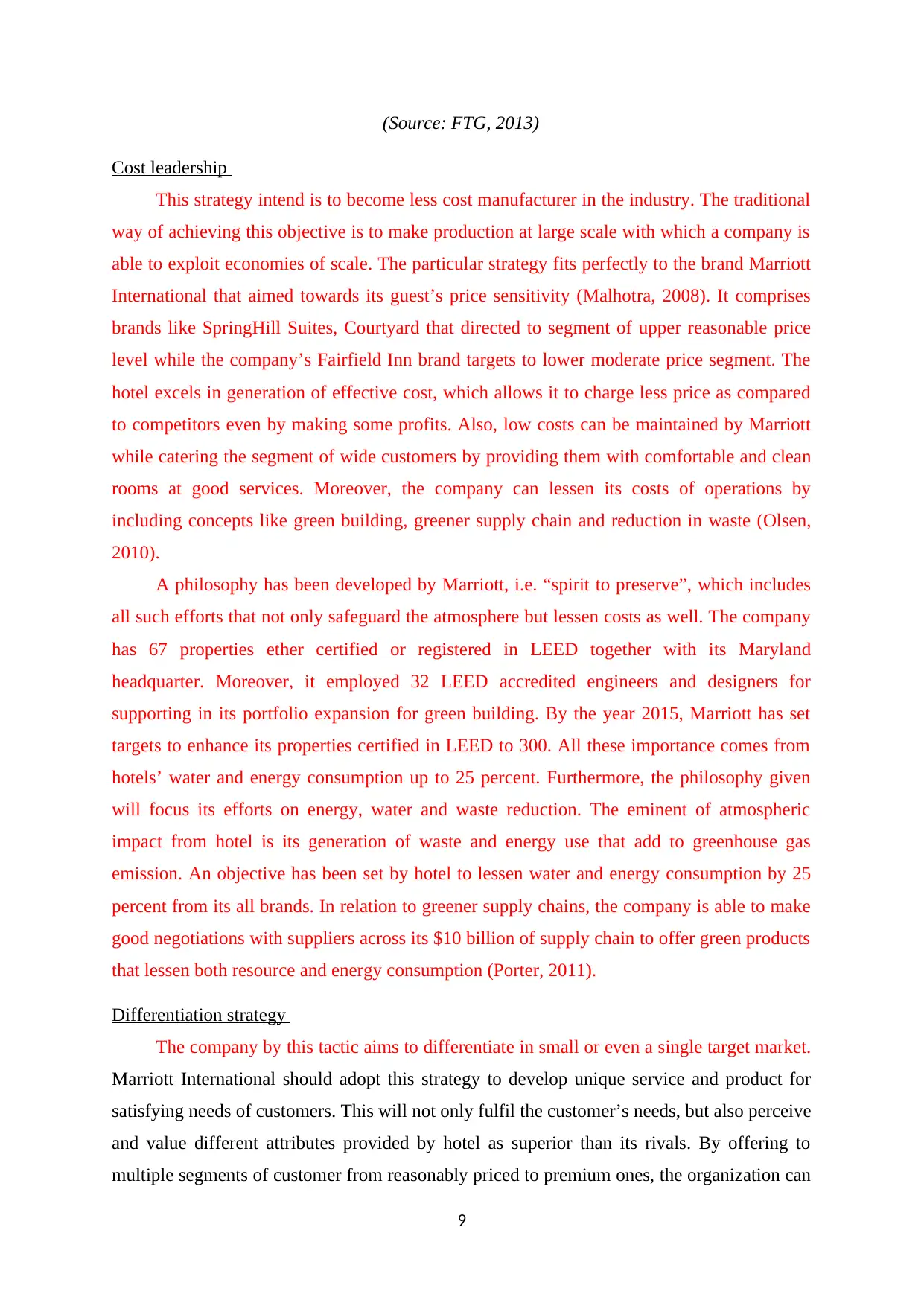
(Source: FTG, 2013)
Cost leadership
This strategy intend is to become less cost manufacturer in the industry. The traditional
way of achieving this objective is to make production at large scale with which a company is
able to exploit economies of scale. The particular strategy fits perfectly to the brand Marriott
International that aimed towards its guest’s price sensitivity (Malhotra, 2008). It comprises
brands like SpringHill Suites, Courtyard that directed to segment of upper reasonable price
level while the company’s Fairfield Inn brand targets to lower moderate price segment. The
hotel excels in generation of effective cost, which allows it to charge less price as compared
to competitors even by making some profits. Also, low costs can be maintained by Marriott
while catering the segment of wide customers by providing them with comfortable and clean
rooms at good services. Moreover, the company can lessen its costs of operations by
including concepts like green building, greener supply chain and reduction in waste (Olsen,
2010).
A philosophy has been developed by Marriott, i.e. “spirit to preserve”, which includes
all such efforts that not only safeguard the atmosphere but lessen costs as well. The company
has 67 properties ether certified or registered in LEED together with its Maryland
headquarter. Moreover, it employed 32 LEED accredited engineers and designers for
supporting in its portfolio expansion for green building. By the year 2015, Marriott has set
targets to enhance its properties certified in LEED to 300. All these importance comes from
hotels’ water and energy consumption up to 25 percent. Furthermore, the philosophy given
will focus its efforts on energy, water and waste reduction. The eminent of atmospheric
impact from hotel is its generation of waste and energy use that add to greenhouse gas
emission. An objective has been set by hotel to lessen water and energy consumption by 25
percent from its all brands. In relation to greener supply chains, the company is able to make
good negotiations with suppliers across its $10 billion of supply chain to offer green products
that lessen both resource and energy consumption (Porter, 2011).
Differentiation strategy
The company by this tactic aims to differentiate in small or even a single target market.
Marriott International should adopt this strategy to develop unique service and product for
satisfying needs of customers. This will not only fulfil the customer’s needs, but also perceive
and value different attributes provided by hotel as superior than its rivals. By offering to
multiple segments of customer from reasonably priced to premium ones, the organization can
9
Cost leadership
This strategy intend is to become less cost manufacturer in the industry. The traditional
way of achieving this objective is to make production at large scale with which a company is
able to exploit economies of scale. The particular strategy fits perfectly to the brand Marriott
International that aimed towards its guest’s price sensitivity (Malhotra, 2008). It comprises
brands like SpringHill Suites, Courtyard that directed to segment of upper reasonable price
level while the company’s Fairfield Inn brand targets to lower moderate price segment. The
hotel excels in generation of effective cost, which allows it to charge less price as compared
to competitors even by making some profits. Also, low costs can be maintained by Marriott
while catering the segment of wide customers by providing them with comfortable and clean
rooms at good services. Moreover, the company can lessen its costs of operations by
including concepts like green building, greener supply chain and reduction in waste (Olsen,
2010).
A philosophy has been developed by Marriott, i.e. “spirit to preserve”, which includes
all such efforts that not only safeguard the atmosphere but lessen costs as well. The company
has 67 properties ether certified or registered in LEED together with its Maryland
headquarter. Moreover, it employed 32 LEED accredited engineers and designers for
supporting in its portfolio expansion for green building. By the year 2015, Marriott has set
targets to enhance its properties certified in LEED to 300. All these importance comes from
hotels’ water and energy consumption up to 25 percent. Furthermore, the philosophy given
will focus its efforts on energy, water and waste reduction. The eminent of atmospheric
impact from hotel is its generation of waste and energy use that add to greenhouse gas
emission. An objective has been set by hotel to lessen water and energy consumption by 25
percent from its all brands. In relation to greener supply chains, the company is able to make
good negotiations with suppliers across its $10 billion of supply chain to offer green products
that lessen both resource and energy consumption (Porter, 2011).
Differentiation strategy
The company by this tactic aims to differentiate in small or even a single target market.
Marriott International should adopt this strategy to develop unique service and product for
satisfying needs of customers. This will not only fulfil the customer’s needs, but also perceive
and value different attributes provided by hotel as superior than its rivals. By offering to
multiple segments of customer from reasonably priced to premium ones, the organization can
9
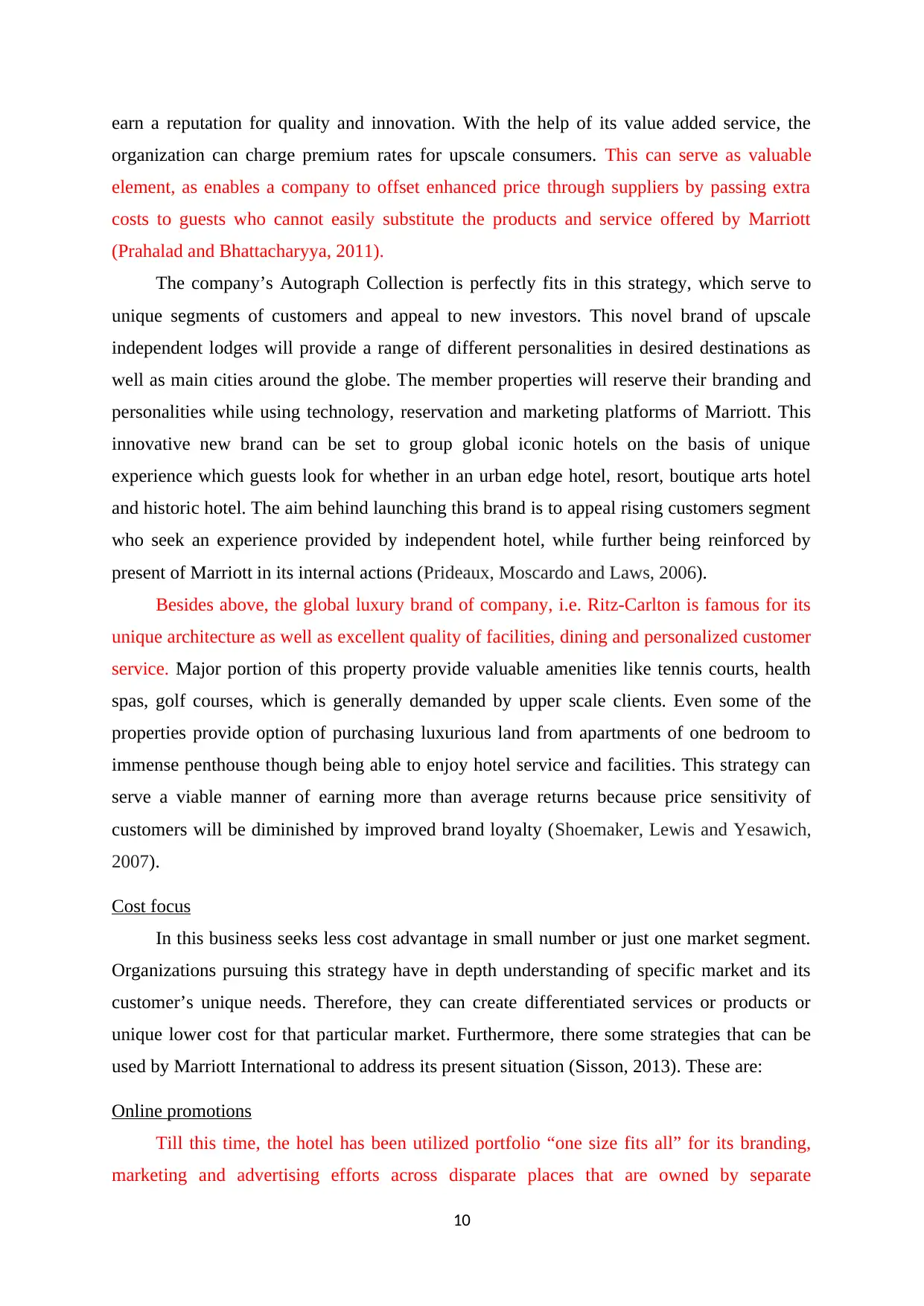
earn a reputation for quality and innovation. With the help of its value added service, the
organization can charge premium rates for upscale consumers. This can serve as valuable
element, as enables a company to offset enhanced price through suppliers by passing extra
costs to guests who cannot easily substitute the products and service offered by Marriott
(Prahalad and Bhattacharyya, 2011).
The company’s Autograph Collection is perfectly fits in this strategy, which serve to
unique segments of customers and appeal to new investors. This novel brand of upscale
independent lodges will provide a range of different personalities in desired destinations as
well as main cities around the globe. The member properties will reserve their branding and
personalities while using technology, reservation and marketing platforms of Marriott. This
innovative new brand can be set to group global iconic hotels on the basis of unique
experience which guests look for whether in an urban edge hotel, resort, boutique arts hotel
and historic hotel. The aim behind launching this brand is to appeal rising customers segment
who seek an experience provided by independent hotel, while further being reinforced by
present of Marriott in its internal actions (Prideaux, Moscardo and Laws, 2006).
Besides above, the global luxury brand of company, i.e. Ritz-Carlton is famous for its
unique architecture as well as excellent quality of facilities, dining and personalized customer
service. Major portion of this property provide valuable amenities like tennis courts, health
spas, golf courses, which is generally demanded by upper scale clients. Even some of the
properties provide option of purchasing luxurious land from apartments of one bedroom to
immense penthouse though being able to enjoy hotel service and facilities. This strategy can
serve a viable manner of earning more than average returns because price sensitivity of
customers will be diminished by improved brand loyalty (Shoemaker, Lewis and Yesawich,
2007).
Cost focus
In this business seeks less cost advantage in small number or just one market segment.
Organizations pursuing this strategy have in depth understanding of specific market and its
customer’s unique needs. Therefore, they can create differentiated services or products or
unique lower cost for that particular market. Furthermore, there some strategies that can be
used by Marriott International to address its present situation (Sisson, 2013). These are:
Online promotions
Till this time, the hotel has been utilized portfolio “one size fits all” for its branding,
marketing and advertising efforts across disparate places that are owned by separate
10
organization can charge premium rates for upscale consumers. This can serve as valuable
element, as enables a company to offset enhanced price through suppliers by passing extra
costs to guests who cannot easily substitute the products and service offered by Marriott
(Prahalad and Bhattacharyya, 2011).
The company’s Autograph Collection is perfectly fits in this strategy, which serve to
unique segments of customers and appeal to new investors. This novel brand of upscale
independent lodges will provide a range of different personalities in desired destinations as
well as main cities around the globe. The member properties will reserve their branding and
personalities while using technology, reservation and marketing platforms of Marriott. This
innovative new brand can be set to group global iconic hotels on the basis of unique
experience which guests look for whether in an urban edge hotel, resort, boutique arts hotel
and historic hotel. The aim behind launching this brand is to appeal rising customers segment
who seek an experience provided by independent hotel, while further being reinforced by
present of Marriott in its internal actions (Prideaux, Moscardo and Laws, 2006).
Besides above, the global luxury brand of company, i.e. Ritz-Carlton is famous for its
unique architecture as well as excellent quality of facilities, dining and personalized customer
service. Major portion of this property provide valuable amenities like tennis courts, health
spas, golf courses, which is generally demanded by upper scale clients. Even some of the
properties provide option of purchasing luxurious land from apartments of one bedroom to
immense penthouse though being able to enjoy hotel service and facilities. This strategy can
serve a viable manner of earning more than average returns because price sensitivity of
customers will be diminished by improved brand loyalty (Shoemaker, Lewis and Yesawich,
2007).
Cost focus
In this business seeks less cost advantage in small number or just one market segment.
Organizations pursuing this strategy have in depth understanding of specific market and its
customer’s unique needs. Therefore, they can create differentiated services or products or
unique lower cost for that particular market. Furthermore, there some strategies that can be
used by Marriott International to address its present situation (Sisson, 2013). These are:
Online promotions
Till this time, the hotel has been utilized portfolio “one size fits all” for its branding,
marketing and advertising efforts across disparate places that are owned by separate
10
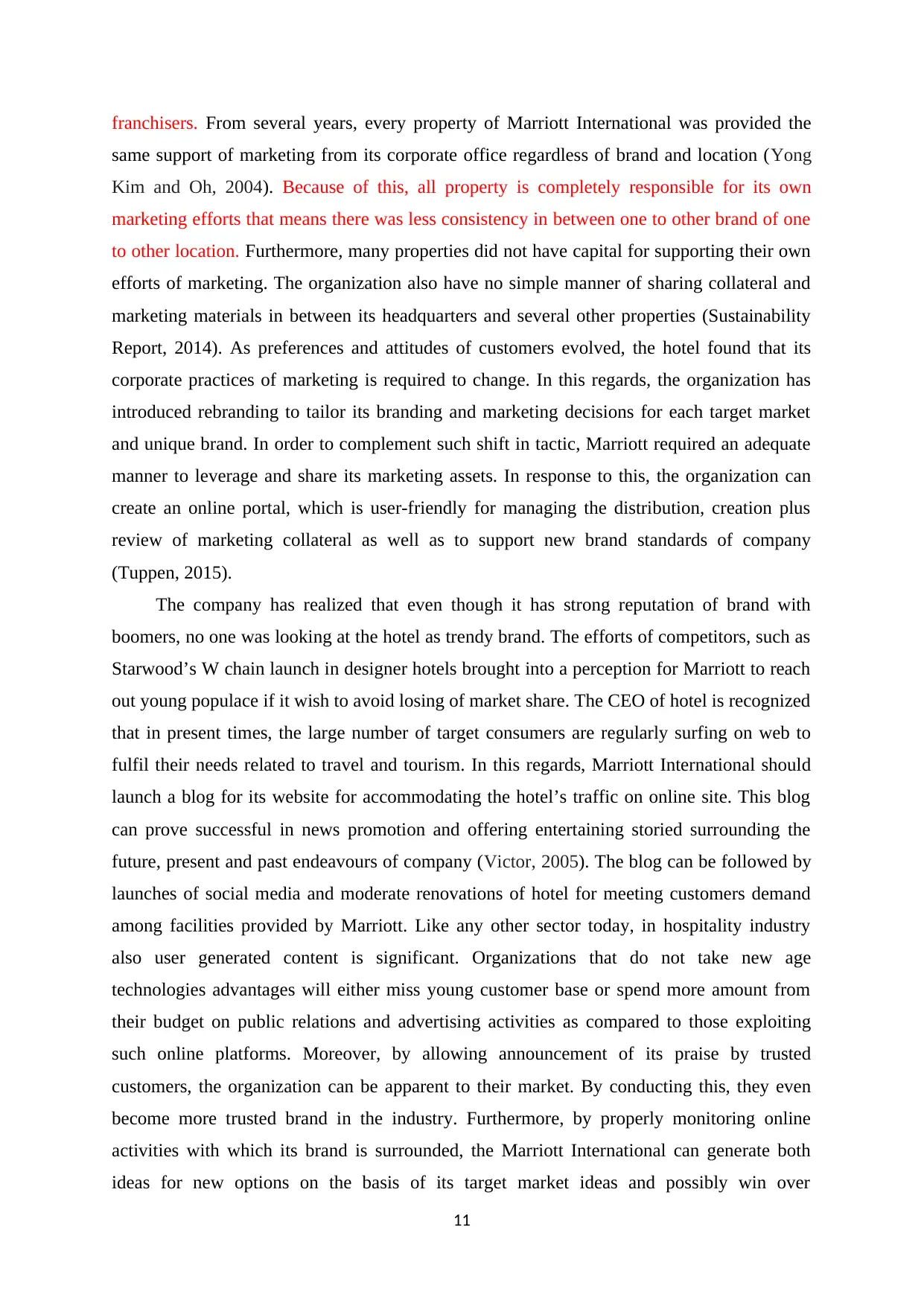
franchisers. From several years, every property of Marriott International was provided the
same support of marketing from its corporate office regardless of brand and location (Yong
Kim and Oh, 2004). Because of this, all property is completely responsible for its own
marketing efforts that means there was less consistency in between one to other brand of one
to other location. Furthermore, many properties did not have capital for supporting their own
efforts of marketing. The organization also have no simple manner of sharing collateral and
marketing materials in between its headquarters and several other properties (Sustainability
Report, 2014). As preferences and attitudes of customers evolved, the hotel found that its
corporate practices of marketing is required to change. In this regards, the organization has
introduced rebranding to tailor its branding and marketing decisions for each target market
and unique brand. In order to complement such shift in tactic, Marriott required an adequate
manner to leverage and share its marketing assets. In response to this, the organization can
create an online portal, which is user-friendly for managing the distribution, creation plus
review of marketing collateral as well as to support new brand standards of company
(Tuppen, 2015).
The company has realized that even though it has strong reputation of brand with
boomers, no one was looking at the hotel as trendy brand. The efforts of competitors, such as
Starwood’s W chain launch in designer hotels brought into a perception for Marriott to reach
out young populace if it wish to avoid losing of market share. The CEO of hotel is recognized
that in present times, the large number of target consumers are regularly surfing on web to
fulfil their needs related to travel and tourism. In this regards, Marriott International should
launch a blog for its website for accommodating the hotel’s traffic on online site. This blog
can prove successful in news promotion and offering entertaining storied surrounding the
future, present and past endeavours of company (Victor, 2005). The blog can be followed by
launches of social media and moderate renovations of hotel for meeting customers demand
among facilities provided by Marriott. Like any other sector today, in hospitality industry
also user generated content is significant. Organizations that do not take new age
technologies advantages will either miss young customer base or spend more amount from
their budget on public relations and advertising activities as compared to those exploiting
such online platforms. Moreover, by allowing announcement of its praise by trusted
customers, the organization can be apparent to their market. By conducting this, they even
become more trusted brand in the industry. Furthermore, by properly monitoring online
activities with which its brand is surrounded, the Marriott International can generate both
ideas for new options on the basis of its target market ideas and possibly win over
11
same support of marketing from its corporate office regardless of brand and location (Yong
Kim and Oh, 2004). Because of this, all property is completely responsible for its own
marketing efforts that means there was less consistency in between one to other brand of one
to other location. Furthermore, many properties did not have capital for supporting their own
efforts of marketing. The organization also have no simple manner of sharing collateral and
marketing materials in between its headquarters and several other properties (Sustainability
Report, 2014). As preferences and attitudes of customers evolved, the hotel found that its
corporate practices of marketing is required to change. In this regards, the organization has
introduced rebranding to tailor its branding and marketing decisions for each target market
and unique brand. In order to complement such shift in tactic, Marriott required an adequate
manner to leverage and share its marketing assets. In response to this, the organization can
create an online portal, which is user-friendly for managing the distribution, creation plus
review of marketing collateral as well as to support new brand standards of company
(Tuppen, 2015).
The company has realized that even though it has strong reputation of brand with
boomers, no one was looking at the hotel as trendy brand. The efforts of competitors, such as
Starwood’s W chain launch in designer hotels brought into a perception for Marriott to reach
out young populace if it wish to avoid losing of market share. The CEO of hotel is recognized
that in present times, the large number of target consumers are regularly surfing on web to
fulfil their needs related to travel and tourism. In this regards, Marriott International should
launch a blog for its website for accommodating the hotel’s traffic on online site. This blog
can prove successful in news promotion and offering entertaining storied surrounding the
future, present and past endeavours of company (Victor, 2005). The blog can be followed by
launches of social media and moderate renovations of hotel for meeting customers demand
among facilities provided by Marriott. Like any other sector today, in hospitality industry
also user generated content is significant. Organizations that do not take new age
technologies advantages will either miss young customer base or spend more amount from
their budget on public relations and advertising activities as compared to those exploiting
such online platforms. Moreover, by allowing announcement of its praise by trusted
customers, the organization can be apparent to their market. By conducting this, they even
become more trusted brand in the industry. Furthermore, by properly monitoring online
activities with which its brand is surrounded, the Marriott International can generate both
ideas for new options on the basis of its target market ideas and possibly win over
11
Paraphrase This Document
Need a fresh take? Get an instant paraphrase of this document with our AI Paraphraser
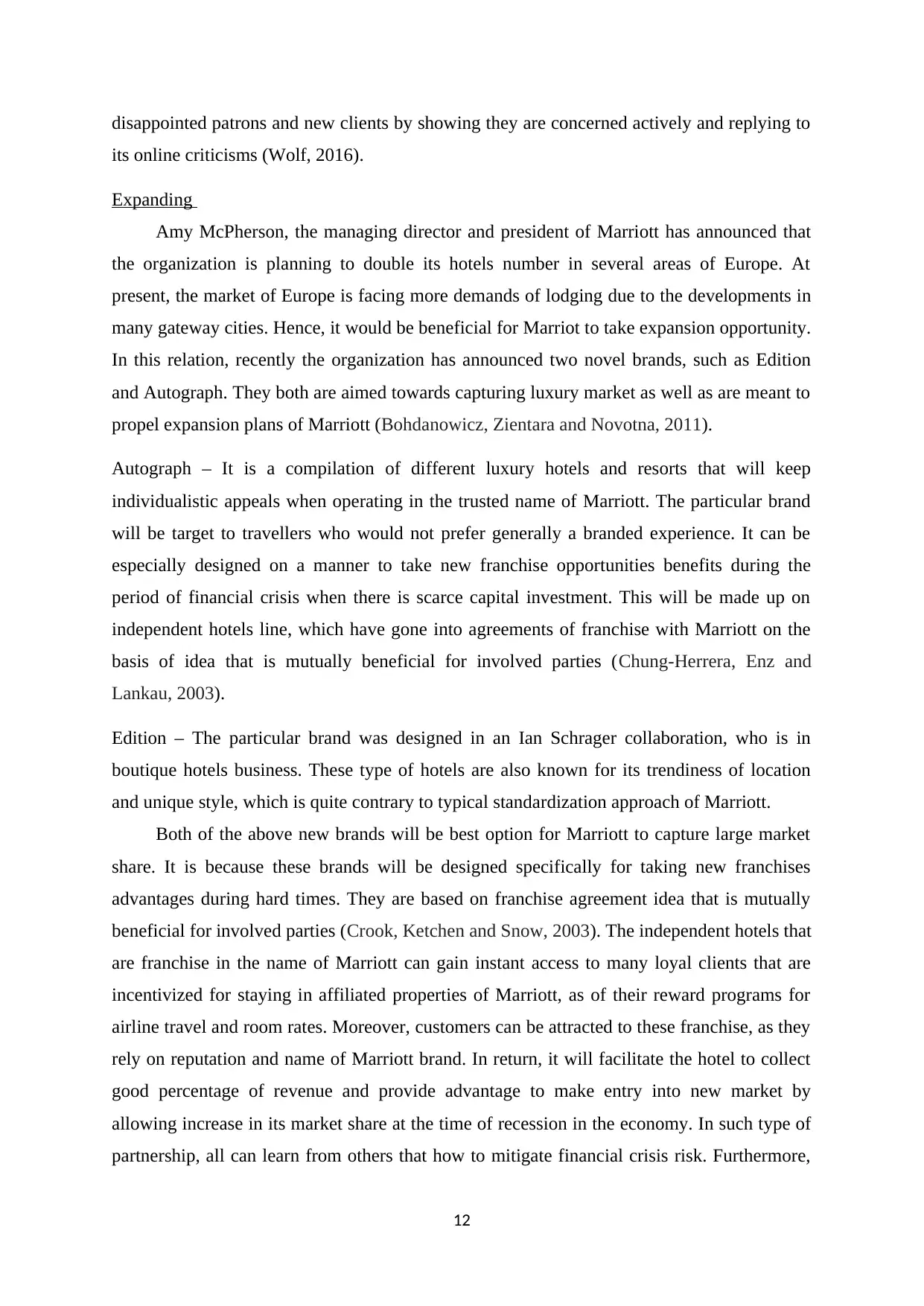
disappointed patrons and new clients by showing they are concerned actively and replying to
its online criticisms (Wolf, 2016).
Expanding
Amy McPherson, the managing director and president of Marriott has announced that
the organization is planning to double its hotels number in several areas of Europe. At
present, the market of Europe is facing more demands of lodging due to the developments in
many gateway cities. Hence, it would be beneficial for Marriot to take expansion opportunity.
In this relation, recently the organization has announced two novel brands, such as Edition
and Autograph. They both are aimed towards capturing luxury market as well as are meant to
propel expansion plans of Marriott (Bohdanowicz, Zientara and Novotna, 2011).
Autograph – It is a compilation of different luxury hotels and resorts that will keep
individualistic appeals when operating in the trusted name of Marriott. The particular brand
will be target to travellers who would not prefer generally a branded experience. It can be
especially designed on a manner to take new franchise opportunities benefits during the
period of financial crisis when there is scarce capital investment. This will be made up on
independent hotels line, which have gone into agreements of franchise with Marriott on the
basis of idea that is mutually beneficial for involved parties (Chung-Herrera, Enz and
Lankau, 2003).
Edition – The particular brand was designed in an Ian Schrager collaboration, who is in
boutique hotels business. These type of hotels are also known for its trendiness of location
and unique style, which is quite contrary to typical standardization approach of Marriott.
Both of the above new brands will be best option for Marriott to capture large market
share. It is because these brands will be designed specifically for taking new franchises
advantages during hard times. They are based on franchise agreement idea that is mutually
beneficial for involved parties (Crook, Ketchen and Snow, 2003). The independent hotels that
are franchise in the name of Marriott can gain instant access to many loyal clients that are
incentivized for staying in affiliated properties of Marriott, as of their reward programs for
airline travel and room rates. Moreover, customers can be attracted to these franchise, as they
rely on reputation and name of Marriott brand. In return, it will facilitate the hotel to collect
good percentage of revenue and provide advantage to make entry into new market by
allowing increase in its market share at the time of recession in the economy. In such type of
partnership, all can learn from others that how to mitigate financial crisis risk. Furthermore,
12
its online criticisms (Wolf, 2016).
Expanding
Amy McPherson, the managing director and president of Marriott has announced that
the organization is planning to double its hotels number in several areas of Europe. At
present, the market of Europe is facing more demands of lodging due to the developments in
many gateway cities. Hence, it would be beneficial for Marriot to take expansion opportunity.
In this relation, recently the organization has announced two novel brands, such as Edition
and Autograph. They both are aimed towards capturing luxury market as well as are meant to
propel expansion plans of Marriott (Bohdanowicz, Zientara and Novotna, 2011).
Autograph – It is a compilation of different luxury hotels and resorts that will keep
individualistic appeals when operating in the trusted name of Marriott. The particular brand
will be target to travellers who would not prefer generally a branded experience. It can be
especially designed on a manner to take new franchise opportunities benefits during the
period of financial crisis when there is scarce capital investment. This will be made up on
independent hotels line, which have gone into agreements of franchise with Marriott on the
basis of idea that is mutually beneficial for involved parties (Chung-Herrera, Enz and
Lankau, 2003).
Edition – The particular brand was designed in an Ian Schrager collaboration, who is in
boutique hotels business. These type of hotels are also known for its trendiness of location
and unique style, which is quite contrary to typical standardization approach of Marriott.
Both of the above new brands will be best option for Marriott to capture large market
share. It is because these brands will be designed specifically for taking new franchises
advantages during hard times. They are based on franchise agreement idea that is mutually
beneficial for involved parties (Crook, Ketchen and Snow, 2003). The independent hotels that
are franchise in the name of Marriott can gain instant access to many loyal clients that are
incentivized for staying in affiliated properties of Marriott, as of their reward programs for
airline travel and room rates. Moreover, customers can be attracted to these franchise, as they
rely on reputation and name of Marriott brand. In return, it will facilitate the hotel to collect
good percentage of revenue and provide advantage to make entry into new market by
allowing increase in its market share at the time of recession in the economy. In such type of
partnership, all can learn from others that how to mitigate financial crisis risk. Furthermore,
12

Marriott can develop its efforts of reaching to trendier audience as well as its respective
partners can learn about efficiency and quality standards from one of the leading hotel of
world (Davidson, 2003).
Focusing on costs cutting
In spite of new plans for expansion, the CEO of Marriott, Arne Sorenson stressed that
the organization need to shift its consideration away from high capital investments in order to
keep the strong balance sheet. The CEO is also encouraging focus on driving more revenue
by improved attention of cost cutting techniques as well as communication and marketing
channels of company. Such cutting in overall cost at resort level can increase the company’s
marginal profit per property without any enhancement in its room rates. At this point of time,
the competition in hotel sector is focused heavily on price and hence increasing rates of room
would not be a good option. Instead, the organization has concentrated on cutting down on
restaurant hours, employees, fuel consumption and water along with other utilities on the
level of property. In this manner, Marriott international would be to save some amount
without losing its competitive price (Dawson, Abbott and Shoemaker, 2011).
Mid-level expansion
Current plans of expansion to both abroad and domestic level are mainly focused on
luxury segment and not considered to the business or mid-level lodging. Marriott
International must look into agreements of franchise with present brands of mid-level hotel in
the same manner as it directed to luxury market. The segment of business is predicted to be
recovering fast the post-recessionary segment because organizations gently begin to enhance
their travelling budget. The hotel already has good experience of mid-level market with its
current Courtyard brand (Dishman and Calof, 2008). By reaching out to properties of mid-
level, which would be interested in probable partnerships, Marriott can expand further its
brand reach as well as enhance market share through less investment of capital, as they ride
the wave out of economic recession. Such partnerships aid to mutual advantages like
extensions of similar recent brand. Marriott through franchising with present hotels can
achieve access to novel markets, particularly from geographical perspective if they remain
focus on European region that at present holds highest rate of growth for the hotel sector. In
response, the entities with which the organization have partnership can attain all possible
benefits under the umbrella brands of Marriott. It also comprises access to frequent rewards
guests of hotel along with reputable and trusted brand name (Enz and Siguaw, 2003).
13
partners can learn about efficiency and quality standards from one of the leading hotel of
world (Davidson, 2003).
Focusing on costs cutting
In spite of new plans for expansion, the CEO of Marriott, Arne Sorenson stressed that
the organization need to shift its consideration away from high capital investments in order to
keep the strong balance sheet. The CEO is also encouraging focus on driving more revenue
by improved attention of cost cutting techniques as well as communication and marketing
channels of company. Such cutting in overall cost at resort level can increase the company’s
marginal profit per property without any enhancement in its room rates. At this point of time,
the competition in hotel sector is focused heavily on price and hence increasing rates of room
would not be a good option. Instead, the organization has concentrated on cutting down on
restaurant hours, employees, fuel consumption and water along with other utilities on the
level of property. In this manner, Marriott international would be to save some amount
without losing its competitive price (Dawson, Abbott and Shoemaker, 2011).
Mid-level expansion
Current plans of expansion to both abroad and domestic level are mainly focused on
luxury segment and not considered to the business or mid-level lodging. Marriott
International must look into agreements of franchise with present brands of mid-level hotel in
the same manner as it directed to luxury market. The segment of business is predicted to be
recovering fast the post-recessionary segment because organizations gently begin to enhance
their travelling budget. The hotel already has good experience of mid-level market with its
current Courtyard brand (Dishman and Calof, 2008). By reaching out to properties of mid-
level, which would be interested in probable partnerships, Marriott can expand further its
brand reach as well as enhance market share through less investment of capital, as they ride
the wave out of economic recession. Such partnerships aid to mutual advantages like
extensions of similar recent brand. Marriott through franchising with present hotels can
achieve access to novel markets, particularly from geographical perspective if they remain
focus on European region that at present holds highest rate of growth for the hotel sector. In
response, the entities with which the organization have partnership can attain all possible
benefits under the umbrella brands of Marriott. It also comprises access to frequent rewards
guests of hotel along with reputable and trusted brand name (Enz and Siguaw, 2003).
13
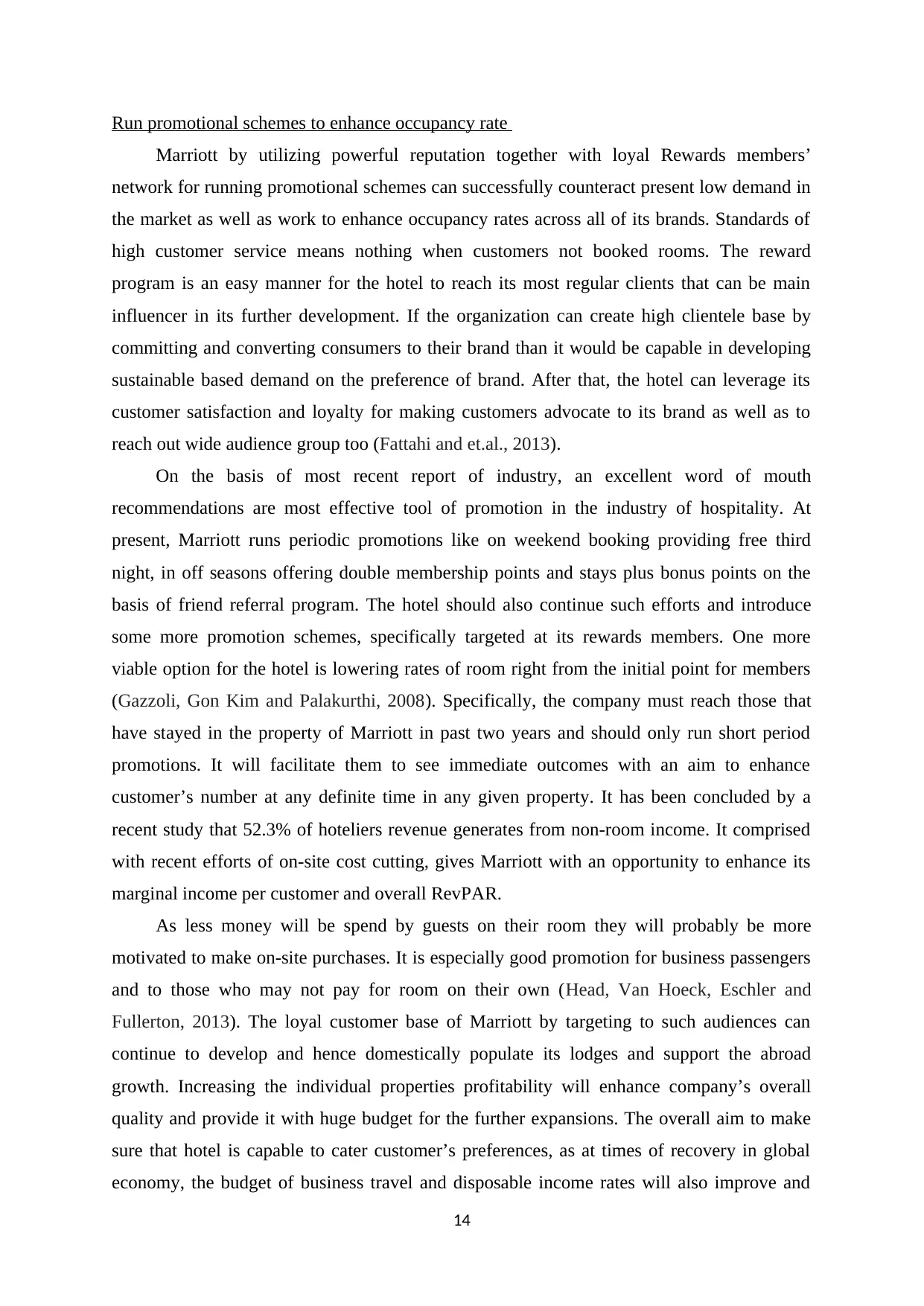
Run promotional schemes to enhance occupancy rate
Marriott by utilizing powerful reputation together with loyal Rewards members’
network for running promotional schemes can successfully counteract present low demand in
the market as well as work to enhance occupancy rates across all of its brands. Standards of
high customer service means nothing when customers not booked rooms. The reward
program is an easy manner for the hotel to reach its most regular clients that can be main
influencer in its further development. If the organization can create high clientele base by
committing and converting consumers to their brand than it would be capable in developing
sustainable based demand on the preference of brand. After that, the hotel can leverage its
customer satisfaction and loyalty for making customers advocate to its brand as well as to
reach out wide audience group too (Fattahi and et.al., 2013).
On the basis of most recent report of industry, an excellent word of mouth
recommendations are most effective tool of promotion in the industry of hospitality. At
present, Marriott runs periodic promotions like on weekend booking providing free third
night, in off seasons offering double membership points and stays plus bonus points on the
basis of friend referral program. The hotel should also continue such efforts and introduce
some more promotion schemes, specifically targeted at its rewards members. One more
viable option for the hotel is lowering rates of room right from the initial point for members
(Gazzoli, Gon Kim and Palakurthi, 2008). Specifically, the company must reach those that
have stayed in the property of Marriott in past two years and should only run short period
promotions. It will facilitate them to see immediate outcomes with an aim to enhance
customer’s number at any definite time in any given property. It has been concluded by a
recent study that 52.3% of hoteliers revenue generates from non-room income. It comprised
with recent efforts of on-site cost cutting, gives Marriott with an opportunity to enhance its
marginal income per customer and overall RevPAR.
As less money will be spend by guests on their room they will probably be more
motivated to make on-site purchases. It is especially good promotion for business passengers
and to those who may not pay for room on their own (Head, Van Hoeck, Eschler and
Fullerton, 2013). The loyal customer base of Marriott by targeting to such audiences can
continue to develop and hence domestically populate its lodges and support the abroad
growth. Increasing the individual properties profitability will enhance company’s overall
quality and provide it with huge budget for the further expansions. The overall aim to make
sure that hotel is capable to cater customer’s preferences, as at times of recovery in global
economy, the budget of business travel and disposable income rates will also improve and
14
Marriott by utilizing powerful reputation together with loyal Rewards members’
network for running promotional schemes can successfully counteract present low demand in
the market as well as work to enhance occupancy rates across all of its brands. Standards of
high customer service means nothing when customers not booked rooms. The reward
program is an easy manner for the hotel to reach its most regular clients that can be main
influencer in its further development. If the organization can create high clientele base by
committing and converting consumers to their brand than it would be capable in developing
sustainable based demand on the preference of brand. After that, the hotel can leverage its
customer satisfaction and loyalty for making customers advocate to its brand as well as to
reach out wide audience group too (Fattahi and et.al., 2013).
On the basis of most recent report of industry, an excellent word of mouth
recommendations are most effective tool of promotion in the industry of hospitality. At
present, Marriott runs periodic promotions like on weekend booking providing free third
night, in off seasons offering double membership points and stays plus bonus points on the
basis of friend referral program. The hotel should also continue such efforts and introduce
some more promotion schemes, specifically targeted at its rewards members. One more
viable option for the hotel is lowering rates of room right from the initial point for members
(Gazzoli, Gon Kim and Palakurthi, 2008). Specifically, the company must reach those that
have stayed in the property of Marriott in past two years and should only run short period
promotions. It will facilitate them to see immediate outcomes with an aim to enhance
customer’s number at any definite time in any given property. It has been concluded by a
recent study that 52.3% of hoteliers revenue generates from non-room income. It comprised
with recent efforts of on-site cost cutting, gives Marriott with an opportunity to enhance its
marginal income per customer and overall RevPAR.
As less money will be spend by guests on their room they will probably be more
motivated to make on-site purchases. It is especially good promotion for business passengers
and to those who may not pay for room on their own (Head, Van Hoeck, Eschler and
Fullerton, 2013). The loyal customer base of Marriott by targeting to such audiences can
continue to develop and hence domestically populate its lodges and support the abroad
growth. Increasing the individual properties profitability will enhance company’s overall
quality and provide it with huge budget for the further expansions. The overall aim to make
sure that hotel is capable to cater customer’s preferences, as at times of recovery in global
economy, the budget of business travel and disposable income rates will also improve and
14
Secure Best Marks with AI Grader
Need help grading? Try our AI Grader for instant feedback on your assignments.
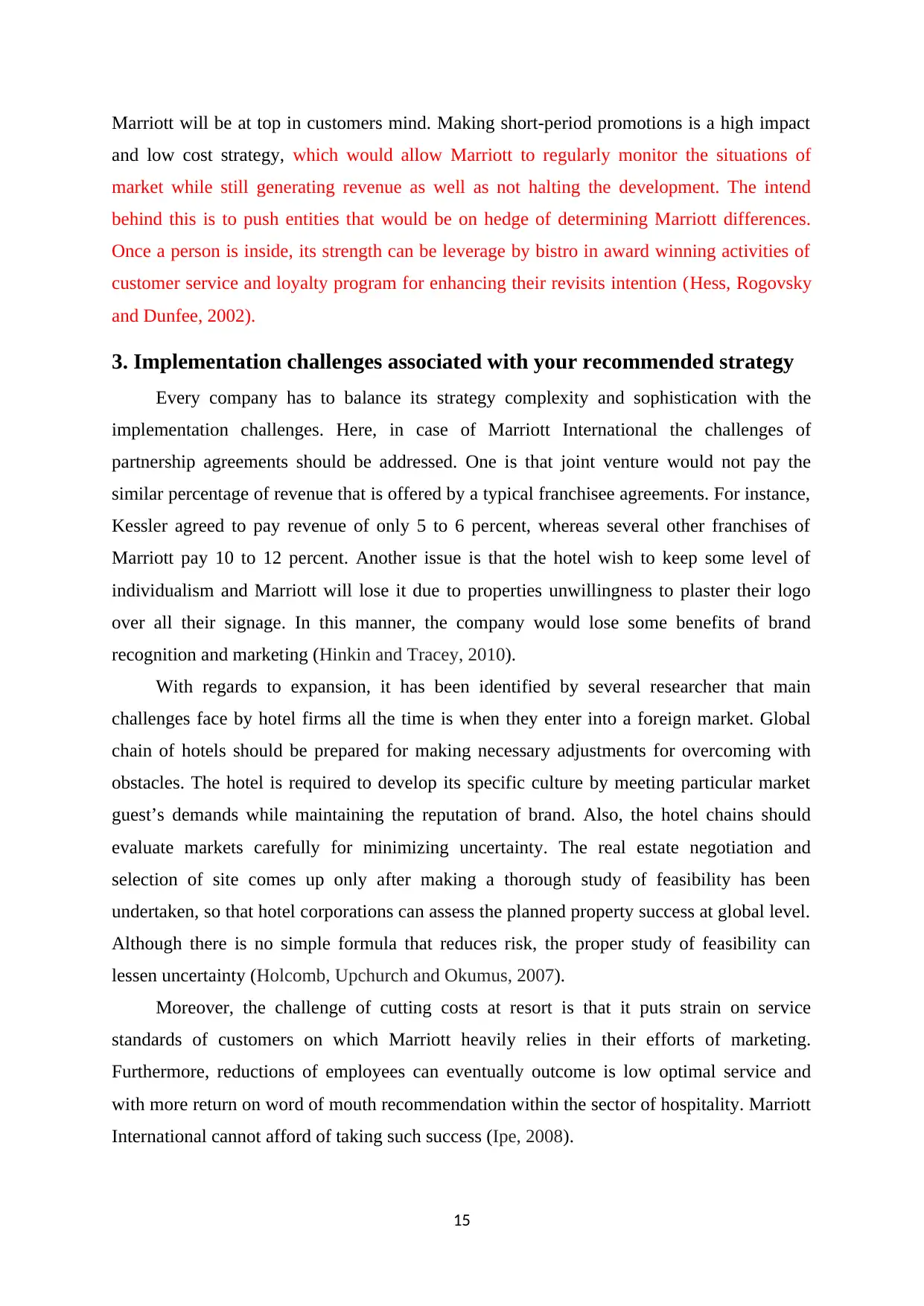
Marriott will be at top in customers mind. Making short-period promotions is a high impact
and low cost strategy, which would allow Marriott to regularly monitor the situations of
market while still generating revenue as well as not halting the development. The intend
behind this is to push entities that would be on hedge of determining Marriott differences.
Once a person is inside, its strength can be leverage by bistro in award winning activities of
customer service and loyalty program for enhancing their revisits intention (Hess, Rogovsky
and Dunfee, 2002).
3. Implementation challenges associated with your recommended strategy
Every company has to balance its strategy complexity and sophistication with the
implementation challenges. Here, in case of Marriott International the challenges of
partnership agreements should be addressed. One is that joint venture would not pay the
similar percentage of revenue that is offered by a typical franchisee agreements. For instance,
Kessler agreed to pay revenue of only 5 to 6 percent, whereas several other franchises of
Marriott pay 10 to 12 percent. Another issue is that the hotel wish to keep some level of
individualism and Marriott will lose it due to properties unwillingness to plaster their logo
over all their signage. In this manner, the company would lose some benefits of brand
recognition and marketing (Hinkin and Tracey, 2010).
With regards to expansion, it has been identified by several researcher that main
challenges face by hotel firms all the time is when they enter into a foreign market. Global
chain of hotels should be prepared for making necessary adjustments for overcoming with
obstacles. The hotel is required to develop its specific culture by meeting particular market
guest’s demands while maintaining the reputation of brand. Also, the hotel chains should
evaluate markets carefully for minimizing uncertainty. The real estate negotiation and
selection of site comes up only after making a thorough study of feasibility has been
undertaken, so that hotel corporations can assess the planned property success at global level.
Although there is no simple formula that reduces risk, the proper study of feasibility can
lessen uncertainty (Holcomb, Upchurch and Okumus, 2007).
Moreover, the challenge of cutting costs at resort is that it puts strain on service
standards of customers on which Marriott heavily relies in their efforts of marketing.
Furthermore, reductions of employees can eventually outcome is low optimal service and
with more return on word of mouth recommendation within the sector of hospitality. Marriott
International cannot afford of taking such success (Ipe, 2008).
15
and low cost strategy, which would allow Marriott to regularly monitor the situations of
market while still generating revenue as well as not halting the development. The intend
behind this is to push entities that would be on hedge of determining Marriott differences.
Once a person is inside, its strength can be leverage by bistro in award winning activities of
customer service and loyalty program for enhancing their revisits intention (Hess, Rogovsky
and Dunfee, 2002).
3. Implementation challenges associated with your recommended strategy
Every company has to balance its strategy complexity and sophistication with the
implementation challenges. Here, in case of Marriott International the challenges of
partnership agreements should be addressed. One is that joint venture would not pay the
similar percentage of revenue that is offered by a typical franchisee agreements. For instance,
Kessler agreed to pay revenue of only 5 to 6 percent, whereas several other franchises of
Marriott pay 10 to 12 percent. Another issue is that the hotel wish to keep some level of
individualism and Marriott will lose it due to properties unwillingness to plaster their logo
over all their signage. In this manner, the company would lose some benefits of brand
recognition and marketing (Hinkin and Tracey, 2010).
With regards to expansion, it has been identified by several researcher that main
challenges face by hotel firms all the time is when they enter into a foreign market. Global
chain of hotels should be prepared for making necessary adjustments for overcoming with
obstacles. The hotel is required to develop its specific culture by meeting particular market
guest’s demands while maintaining the reputation of brand. Also, the hotel chains should
evaluate markets carefully for minimizing uncertainty. The real estate negotiation and
selection of site comes up only after making a thorough study of feasibility has been
undertaken, so that hotel corporations can assess the planned property success at global level.
Although there is no simple formula that reduces risk, the proper study of feasibility can
lessen uncertainty (Holcomb, Upchurch and Okumus, 2007).
Moreover, the challenge of cutting costs at resort is that it puts strain on service
standards of customers on which Marriott heavily relies in their efforts of marketing.
Furthermore, reductions of employees can eventually outcome is low optimal service and
with more return on word of mouth recommendation within the sector of hospitality. Marriott
International cannot afford of taking such success (Ipe, 2008).
15
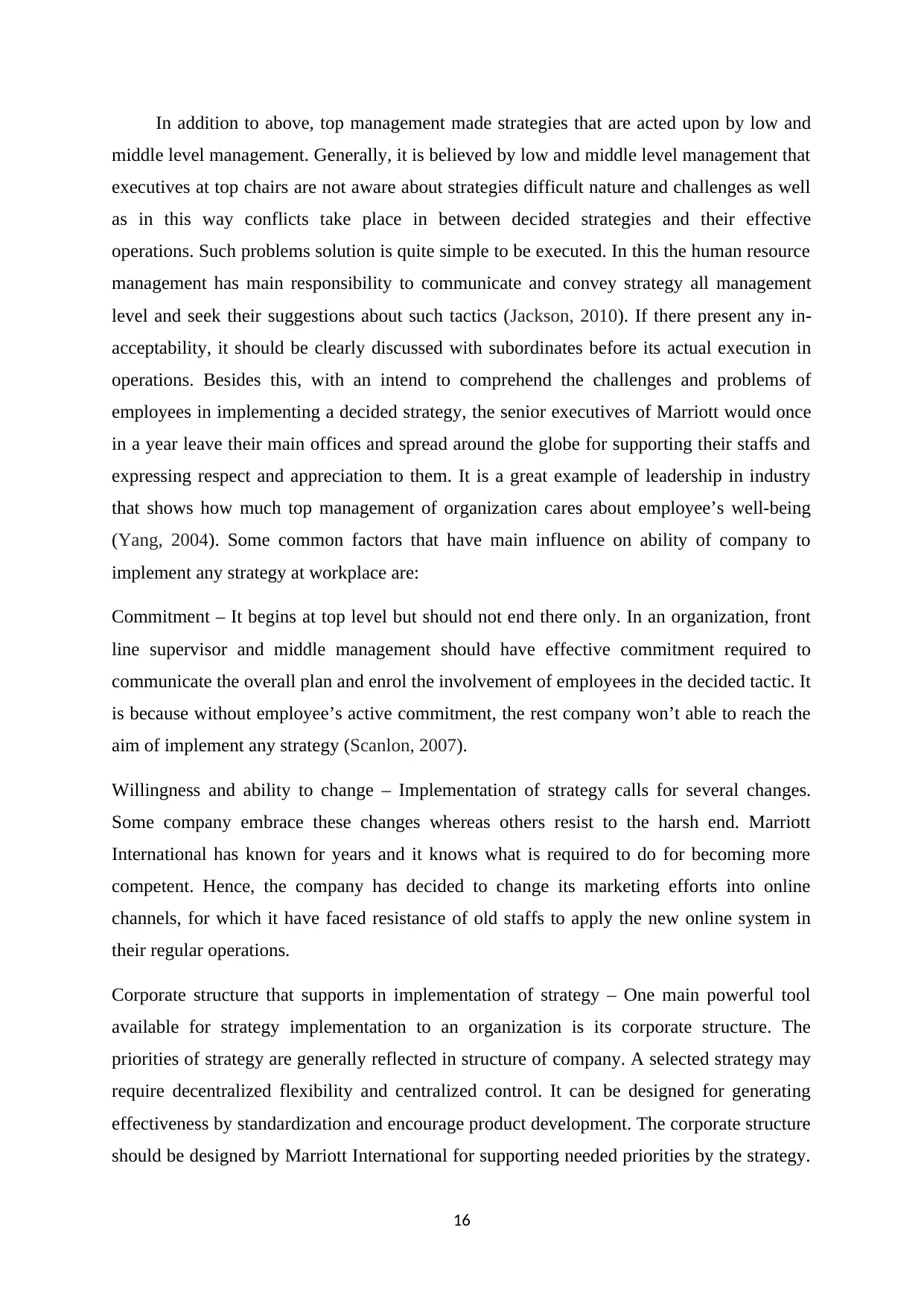
In addition to above, top management made strategies that are acted upon by low and
middle level management. Generally, it is believed by low and middle level management that
executives at top chairs are not aware about strategies difficult nature and challenges as well
as in this way conflicts take place in between decided strategies and their effective
operations. Such problems solution is quite simple to be executed. In this the human resource
management has main responsibility to communicate and convey strategy all management
level and seek their suggestions about such tactics (Jackson, 2010). If there present any in-
acceptability, it should be clearly discussed with subordinates before its actual execution in
operations. Besides this, with an intend to comprehend the challenges and problems of
employees in implementing a decided strategy, the senior executives of Marriott would once
in a year leave their main offices and spread around the globe for supporting their staffs and
expressing respect and appreciation to them. It is a great example of leadership in industry
that shows how much top management of organization cares about employee’s well-being
(Yang, 2004). Some common factors that have main influence on ability of company to
implement any strategy at workplace are:
Commitment – It begins at top level but should not end there only. In an organization, front
line supervisor and middle management should have effective commitment required to
communicate the overall plan and enrol the involvement of employees in the decided tactic. It
is because without employee’s active commitment, the rest company won’t able to reach the
aim of implement any strategy (Scanlon, 2007).
Willingness and ability to change – Implementation of strategy calls for several changes.
Some company embrace these changes whereas others resist to the harsh end. Marriott
International has known for years and it knows what is required to do for becoming more
competent. Hence, the company has decided to change its marketing efforts into online
channels, for which it have faced resistance of old staffs to apply the new online system in
their regular operations.
Corporate structure that supports in implementation of strategy – One main powerful tool
available for strategy implementation to an organization is its corporate structure. The
priorities of strategy are generally reflected in structure of company. A selected strategy may
require decentralized flexibility and centralized control. It can be designed for generating
effectiveness by standardization and encourage product development. The corporate structure
should be designed by Marriott International for supporting needed priorities by the strategy.
16
middle level management. Generally, it is believed by low and middle level management that
executives at top chairs are not aware about strategies difficult nature and challenges as well
as in this way conflicts take place in between decided strategies and their effective
operations. Such problems solution is quite simple to be executed. In this the human resource
management has main responsibility to communicate and convey strategy all management
level and seek their suggestions about such tactics (Jackson, 2010). If there present any in-
acceptability, it should be clearly discussed with subordinates before its actual execution in
operations. Besides this, with an intend to comprehend the challenges and problems of
employees in implementing a decided strategy, the senior executives of Marriott would once
in a year leave their main offices and spread around the globe for supporting their staffs and
expressing respect and appreciation to them. It is a great example of leadership in industry
that shows how much top management of organization cares about employee’s well-being
(Yang, 2004). Some common factors that have main influence on ability of company to
implement any strategy at workplace are:
Commitment – It begins at top level but should not end there only. In an organization, front
line supervisor and middle management should have effective commitment required to
communicate the overall plan and enrol the involvement of employees in the decided tactic. It
is because without employee’s active commitment, the rest company won’t able to reach the
aim of implement any strategy (Scanlon, 2007).
Willingness and ability to change – Implementation of strategy calls for several changes.
Some company embrace these changes whereas others resist to the harsh end. Marriott
International has known for years and it knows what is required to do for becoming more
competent. Hence, the company has decided to change its marketing efforts into online
channels, for which it have faced resistance of old staffs to apply the new online system in
their regular operations.
Corporate structure that supports in implementation of strategy – One main powerful tool
available for strategy implementation to an organization is its corporate structure. The
priorities of strategy are generally reflected in structure of company. A selected strategy may
require decentralized flexibility and centralized control. It can be designed for generating
effectiveness by standardization and encourage product development. The corporate structure
should be designed by Marriott International for supporting needed priorities by the strategy.
16
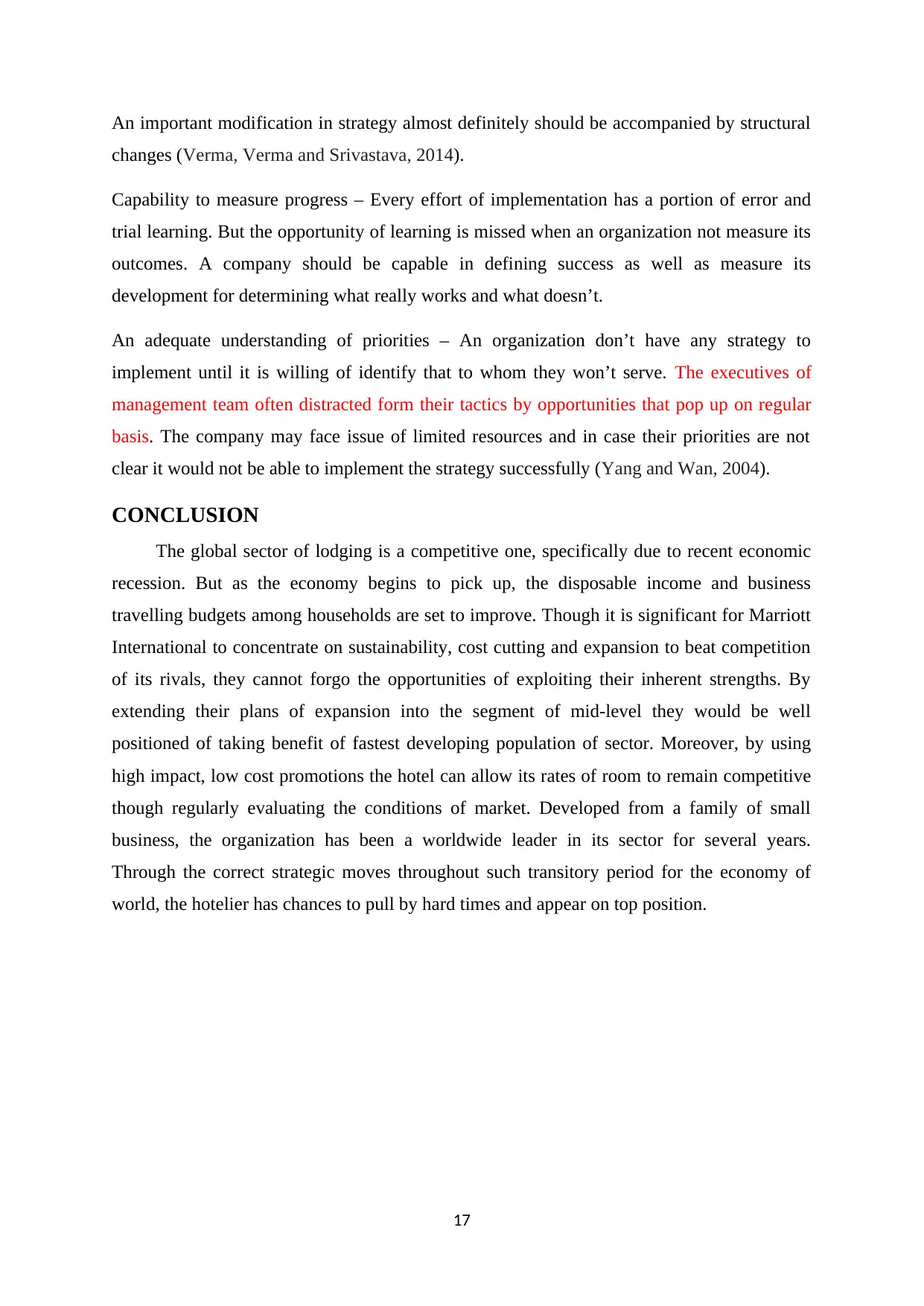
An important modification in strategy almost definitely should be accompanied by structural
changes (Verma, Verma and Srivastava, 2014).
Capability to measure progress – Every effort of implementation has a portion of error and
trial learning. But the opportunity of learning is missed when an organization not measure its
outcomes. A company should be capable in defining success as well as measure its
development for determining what really works and what doesn’t.
An adequate understanding of priorities – An organization don’t have any strategy to
implement until it is willing of identify that to whom they won’t serve. The executives of
management team often distracted form their tactics by opportunities that pop up on regular
basis. The company may face issue of limited resources and in case their priorities are not
clear it would not be able to implement the strategy successfully (Yang and Wan, 2004).
CONCLUSION
The global sector of lodging is a competitive one, specifically due to recent economic
recession. But as the economy begins to pick up, the disposable income and business
travelling budgets among households are set to improve. Though it is significant for Marriott
International to concentrate on sustainability, cost cutting and expansion to beat competition
of its rivals, they cannot forgo the opportunities of exploiting their inherent strengths. By
extending their plans of expansion into the segment of mid-level they would be well
positioned of taking benefit of fastest developing population of sector. Moreover, by using
high impact, low cost promotions the hotel can allow its rates of room to remain competitive
though regularly evaluating the conditions of market. Developed from a family of small
business, the organization has been a worldwide leader in its sector for several years.
Through the correct strategic moves throughout such transitory period for the economy of
world, the hotelier has chances to pull by hard times and appear on top position.
17
changes (Verma, Verma and Srivastava, 2014).
Capability to measure progress – Every effort of implementation has a portion of error and
trial learning. But the opportunity of learning is missed when an organization not measure its
outcomes. A company should be capable in defining success as well as measure its
development for determining what really works and what doesn’t.
An adequate understanding of priorities – An organization don’t have any strategy to
implement until it is willing of identify that to whom they won’t serve. The executives of
management team often distracted form their tactics by opportunities that pop up on regular
basis. The company may face issue of limited resources and in case their priorities are not
clear it would not be able to implement the strategy successfully (Yang and Wan, 2004).
CONCLUSION
The global sector of lodging is a competitive one, specifically due to recent economic
recession. But as the economy begins to pick up, the disposable income and business
travelling budgets among households are set to improve. Though it is significant for Marriott
International to concentrate on sustainability, cost cutting and expansion to beat competition
of its rivals, they cannot forgo the opportunities of exploiting their inherent strengths. By
extending their plans of expansion into the segment of mid-level they would be well
positioned of taking benefit of fastest developing population of sector. Moreover, by using
high impact, low cost promotions the hotel can allow its rates of room to remain competitive
though regularly evaluating the conditions of market. Developed from a family of small
business, the organization has been a worldwide leader in its sector for several years.
Through the correct strategic moves throughout such transitory period for the economy of
world, the hotelier has chances to pull by hard times and appear on top position.
17
Paraphrase This Document
Need a fresh take? Get an instant paraphrase of this document with our AI Paraphraser
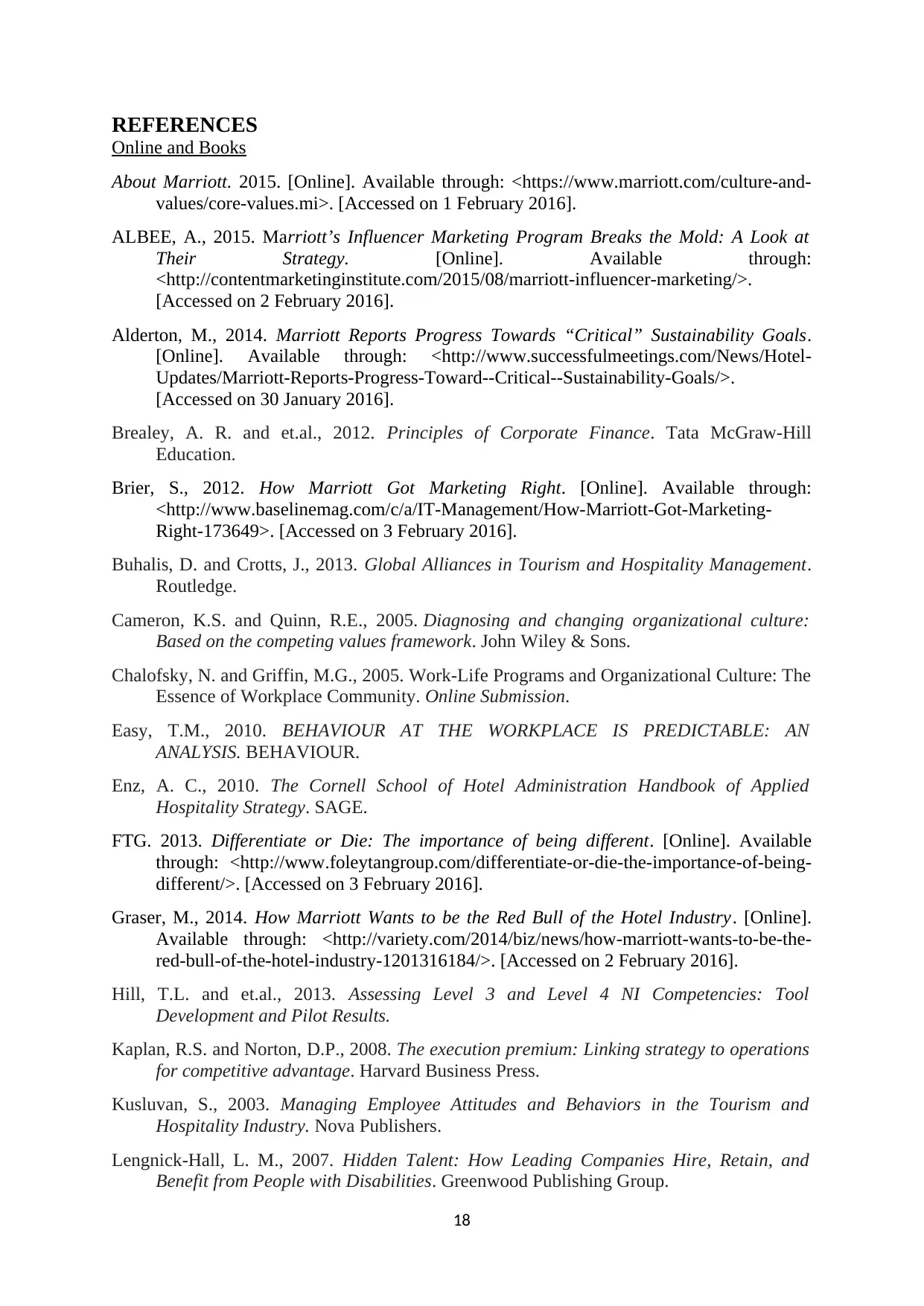
REFERENCES
Online and Books
About Marriott. 2015. [Online]. Available through: <https://www.marriott.com/culture-and-
values/core-values.mi>. [Accessed on 1 February 2016].
ALBEE, A., 2015. Marriott’s Influencer Marketing Program Breaks the Mold: A Look at
Their Strategy. [Online]. Available through:
<http://contentmarketinginstitute.com/2015/08/marriott-influencer-marketing/>.
[Accessed on 2 February 2016].
Alderton, M., 2014. Marriott Reports Progress Towards “Critical” Sustainability Goals.
[Online]. Available through: <http://www.successfulmeetings.com/News/Hotel-
Updates/Marriott-Reports-Progress-Toward--Critical--Sustainability-Goals/>.
[Accessed on 30 January 2016].
Brealey, A. R. and et.al., 2012. Principles of Corporate Finance. Tata McGraw-Hill
Education.
Brier, S., 2012. How Marriott Got Marketing Right. [Online]. Available through:
<http://www.baselinemag.com/c/a/IT-Management/How-Marriott-Got-Marketing-
Right-173649>. [Accessed on 3 February 2016].
Buhalis, D. and Crotts, J., 2013. Global Alliances in Tourism and Hospitality Management.
Routledge.
Cameron, K.S. and Quinn, R.E., 2005. Diagnosing and changing organizational culture:
Based on the competing values framework. John Wiley & Sons.
Chalofsky, N. and Griffin, M.G., 2005. Work-Life Programs and Organizational Culture: The
Essence of Workplace Community. Online Submission.
Easy, T.M., 2010. BEHAVIOUR AT THE WORKPLACE IS PREDICTABLE: AN
ANALYSIS. BEHAVIOUR.
Enz, A. C., 2010. The Cornell School of Hotel Administration Handbook of Applied
Hospitality Strategy. SAGE.
FTG. 2013. Differentiate or Die: The importance of being different. [Online]. Available
through: <http://www.foleytangroup.com/differentiate-or-die-the-importance-of-being-
different/>. [Accessed on 3 February 2016].
Graser, M., 2014. How Marriott Wants to be the Red Bull of the Hotel Industry. [Online].
Available through: <http://variety.com/2014/biz/news/how-marriott-wants-to-be-the-
red-bull-of-the-hotel-industry-1201316184/>. [Accessed on 2 February 2016].
Hill, T.L. and et.al., 2013. Assessing Level 3 and Level 4 NI Competencies: Tool
Development and Pilot Results.
Kaplan, R.S. and Norton, D.P., 2008. The execution premium: Linking strategy to operations
for competitive advantage. Harvard Business Press.
Kusluvan, S., 2003. Managing Employee Attitudes and Behaviors in the Tourism and
Hospitality Industry. Nova Publishers.
Lengnick-Hall, L. M., 2007. Hidden Talent: How Leading Companies Hire, Retain, and
Benefit from People with Disabilities. Greenwood Publishing Group.
18
Online and Books
About Marriott. 2015. [Online]. Available through: <https://www.marriott.com/culture-and-
values/core-values.mi>. [Accessed on 1 February 2016].
ALBEE, A., 2015. Marriott’s Influencer Marketing Program Breaks the Mold: A Look at
Their Strategy. [Online]. Available through:
<http://contentmarketinginstitute.com/2015/08/marriott-influencer-marketing/>.
[Accessed on 2 February 2016].
Alderton, M., 2014. Marriott Reports Progress Towards “Critical” Sustainability Goals.
[Online]. Available through: <http://www.successfulmeetings.com/News/Hotel-
Updates/Marriott-Reports-Progress-Toward--Critical--Sustainability-Goals/>.
[Accessed on 30 January 2016].
Brealey, A. R. and et.al., 2012. Principles of Corporate Finance. Tata McGraw-Hill
Education.
Brier, S., 2012. How Marriott Got Marketing Right. [Online]. Available through:
<http://www.baselinemag.com/c/a/IT-Management/How-Marriott-Got-Marketing-
Right-173649>. [Accessed on 3 February 2016].
Buhalis, D. and Crotts, J., 2013. Global Alliances in Tourism and Hospitality Management.
Routledge.
Cameron, K.S. and Quinn, R.E., 2005. Diagnosing and changing organizational culture:
Based on the competing values framework. John Wiley & Sons.
Chalofsky, N. and Griffin, M.G., 2005. Work-Life Programs and Organizational Culture: The
Essence of Workplace Community. Online Submission.
Easy, T.M., 2010. BEHAVIOUR AT THE WORKPLACE IS PREDICTABLE: AN
ANALYSIS. BEHAVIOUR.
Enz, A. C., 2010. The Cornell School of Hotel Administration Handbook of Applied
Hospitality Strategy. SAGE.
FTG. 2013. Differentiate or Die: The importance of being different. [Online]. Available
through: <http://www.foleytangroup.com/differentiate-or-die-the-importance-of-being-
different/>. [Accessed on 3 February 2016].
Graser, M., 2014. How Marriott Wants to be the Red Bull of the Hotel Industry. [Online].
Available through: <http://variety.com/2014/biz/news/how-marriott-wants-to-be-the-
red-bull-of-the-hotel-industry-1201316184/>. [Accessed on 2 February 2016].
Hill, T.L. and et.al., 2013. Assessing Level 3 and Level 4 NI Competencies: Tool
Development and Pilot Results.
Kaplan, R.S. and Norton, D.P., 2008. The execution premium: Linking strategy to operations
for competitive advantage. Harvard Business Press.
Kusluvan, S., 2003. Managing Employee Attitudes and Behaviors in the Tourism and
Hospitality Industry. Nova Publishers.
Lengnick-Hall, L. M., 2007. Hidden Talent: How Leading Companies Hire, Retain, and
Benefit from People with Disabilities. Greenwood Publishing Group.
18
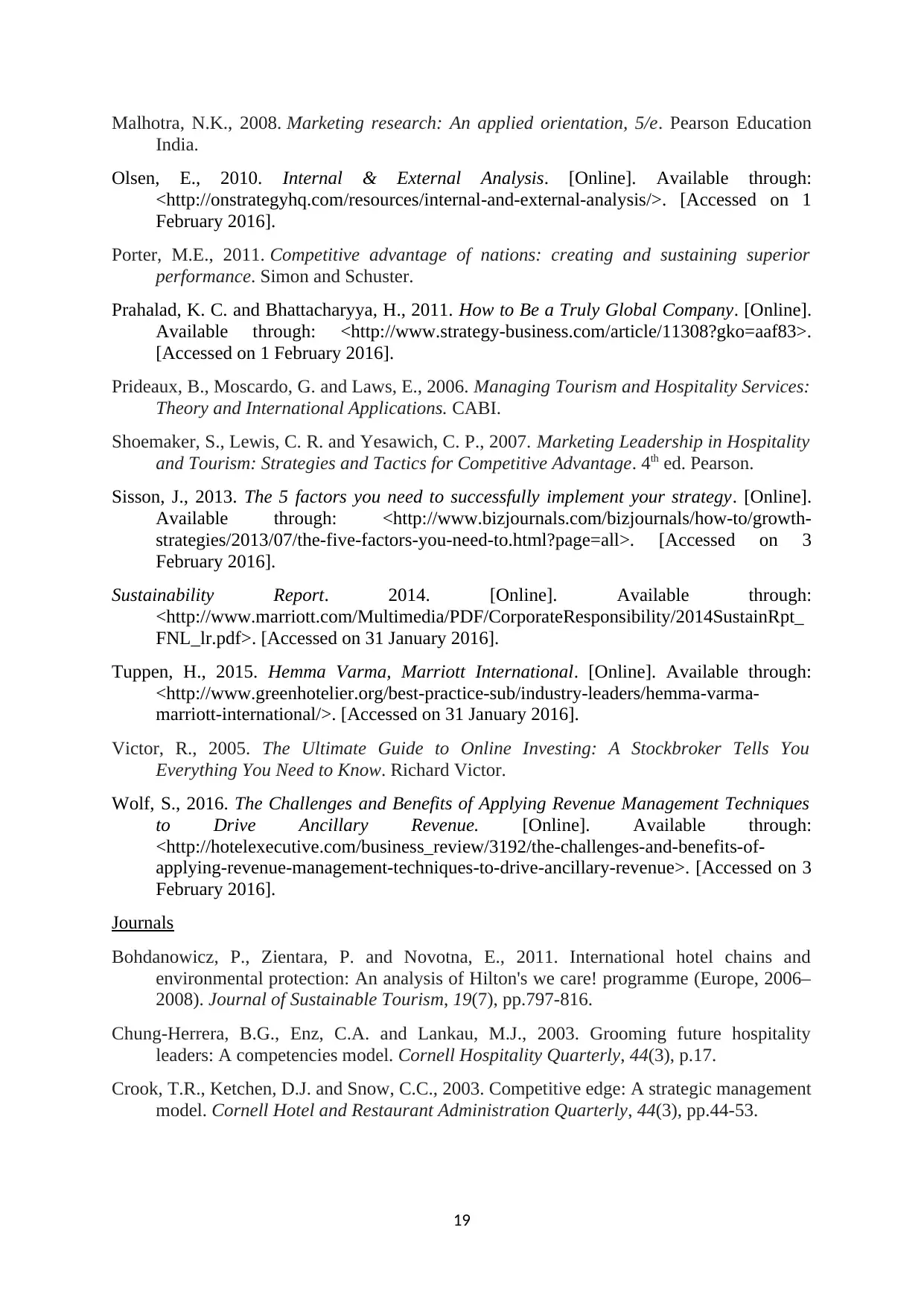
Malhotra, N.K., 2008. Marketing research: An applied orientation, 5/e. Pearson Education
India.
Olsen, E., 2010. Internal & External Analysis. [Online]. Available through:
<http://onstrategyhq.com/resources/internal-and-external-analysis/>. [Accessed on 1
February 2016].
Porter, M.E., 2011. Competitive advantage of nations: creating and sustaining superior
performance. Simon and Schuster.
Prahalad, K. C. and Bhattacharyya, H., 2011. How to Be a Truly Global Company. [Online].
Available through: <http://www.strategy-business.com/article/11308?gko=aaf83>.
[Accessed on 1 February 2016].
Prideaux, B., Moscardo, G. and Laws, E., 2006. Managing Tourism and Hospitality Services:
Theory and International Applications. CABI.
Shoemaker, S., Lewis, C. R. and Yesawich, C. P., 2007. Marketing Leadership in Hospitality
and Tourism: Strategies and Tactics for Competitive Advantage. 4th ed. Pearson.
Sisson, J., 2013. The 5 factors you need to successfully implement your strategy. [Online].
Available through: <http://www.bizjournals.com/bizjournals/how-to/growth-
strategies/2013/07/the-five-factors-you-need-to.html?page=all>. [Accessed on 3
February 2016].
Sustainability Report. 2014. [Online]. Available through:
<http://www.marriott.com/Multimedia/PDF/CorporateResponsibility/2014SustainRpt_
FNL_lr.pdf>. [Accessed on 31 January 2016].
Tuppen, H., 2015. Hemma Varma, Marriott International. [Online]. Available through:
<http://www.greenhotelier.org/best-practice-sub/industry-leaders/hemma-varma-
marriott-international/>. [Accessed on 31 January 2016].
Victor, R., 2005. The Ultimate Guide to Online Investing: A Stockbroker Tells You
Everything You Need to Know. Richard Victor.
Wolf, S., 2016. The Challenges and Benefits of Applying Revenue Management Techniques
to Drive Ancillary Revenue. [Online]. Available through:
<http://hotelexecutive.com/business_review/3192/the-challenges-and-benefits-of-
applying-revenue-management-techniques-to-drive-ancillary-revenue>. [Accessed on 3
February 2016].
Journals
Bohdanowicz, P., Zientara, P. and Novotna, E., 2011. International hotel chains and
environmental protection: An analysis of Hilton's we care! programme (Europe, 2006–
2008). Journal of Sustainable Tourism, 19(7), pp.797-816.
Chung-Herrera, B.G., Enz, C.A. and Lankau, M.J., 2003. Grooming future hospitality
leaders: A competencies model. Cornell Hospitality Quarterly, 44(3), p.17.
Crook, T.R., Ketchen, D.J. and Snow, C.C., 2003. Competitive edge: A strategic management
model. Cornell Hotel and Restaurant Administration Quarterly, 44(3), pp.44-53.
19
India.
Olsen, E., 2010. Internal & External Analysis. [Online]. Available through:
<http://onstrategyhq.com/resources/internal-and-external-analysis/>. [Accessed on 1
February 2016].
Porter, M.E., 2011. Competitive advantage of nations: creating and sustaining superior
performance. Simon and Schuster.
Prahalad, K. C. and Bhattacharyya, H., 2011. How to Be a Truly Global Company. [Online].
Available through: <http://www.strategy-business.com/article/11308?gko=aaf83>.
[Accessed on 1 February 2016].
Prideaux, B., Moscardo, G. and Laws, E., 2006. Managing Tourism and Hospitality Services:
Theory and International Applications. CABI.
Shoemaker, S., Lewis, C. R. and Yesawich, C. P., 2007. Marketing Leadership in Hospitality
and Tourism: Strategies and Tactics for Competitive Advantage. 4th ed. Pearson.
Sisson, J., 2013. The 5 factors you need to successfully implement your strategy. [Online].
Available through: <http://www.bizjournals.com/bizjournals/how-to/growth-
strategies/2013/07/the-five-factors-you-need-to.html?page=all>. [Accessed on 3
February 2016].
Sustainability Report. 2014. [Online]. Available through:
<http://www.marriott.com/Multimedia/PDF/CorporateResponsibility/2014SustainRpt_
FNL_lr.pdf>. [Accessed on 31 January 2016].
Tuppen, H., 2015. Hemma Varma, Marriott International. [Online]. Available through:
<http://www.greenhotelier.org/best-practice-sub/industry-leaders/hemma-varma-
marriott-international/>. [Accessed on 31 January 2016].
Victor, R., 2005. The Ultimate Guide to Online Investing: A Stockbroker Tells You
Everything You Need to Know. Richard Victor.
Wolf, S., 2016. The Challenges and Benefits of Applying Revenue Management Techniques
to Drive Ancillary Revenue. [Online]. Available through:
<http://hotelexecutive.com/business_review/3192/the-challenges-and-benefits-of-
applying-revenue-management-techniques-to-drive-ancillary-revenue>. [Accessed on 3
February 2016].
Journals
Bohdanowicz, P., Zientara, P. and Novotna, E., 2011. International hotel chains and
environmental protection: An analysis of Hilton's we care! programme (Europe, 2006–
2008). Journal of Sustainable Tourism, 19(7), pp.797-816.
Chung-Herrera, B.G., Enz, C.A. and Lankau, M.J., 2003. Grooming future hospitality
leaders: A competencies model. Cornell Hospitality Quarterly, 44(3), p.17.
Crook, T.R., Ketchen, D.J. and Snow, C.C., 2003. Competitive edge: A strategic management
model. Cornell Hotel and Restaurant Administration Quarterly, 44(3), pp.44-53.
19
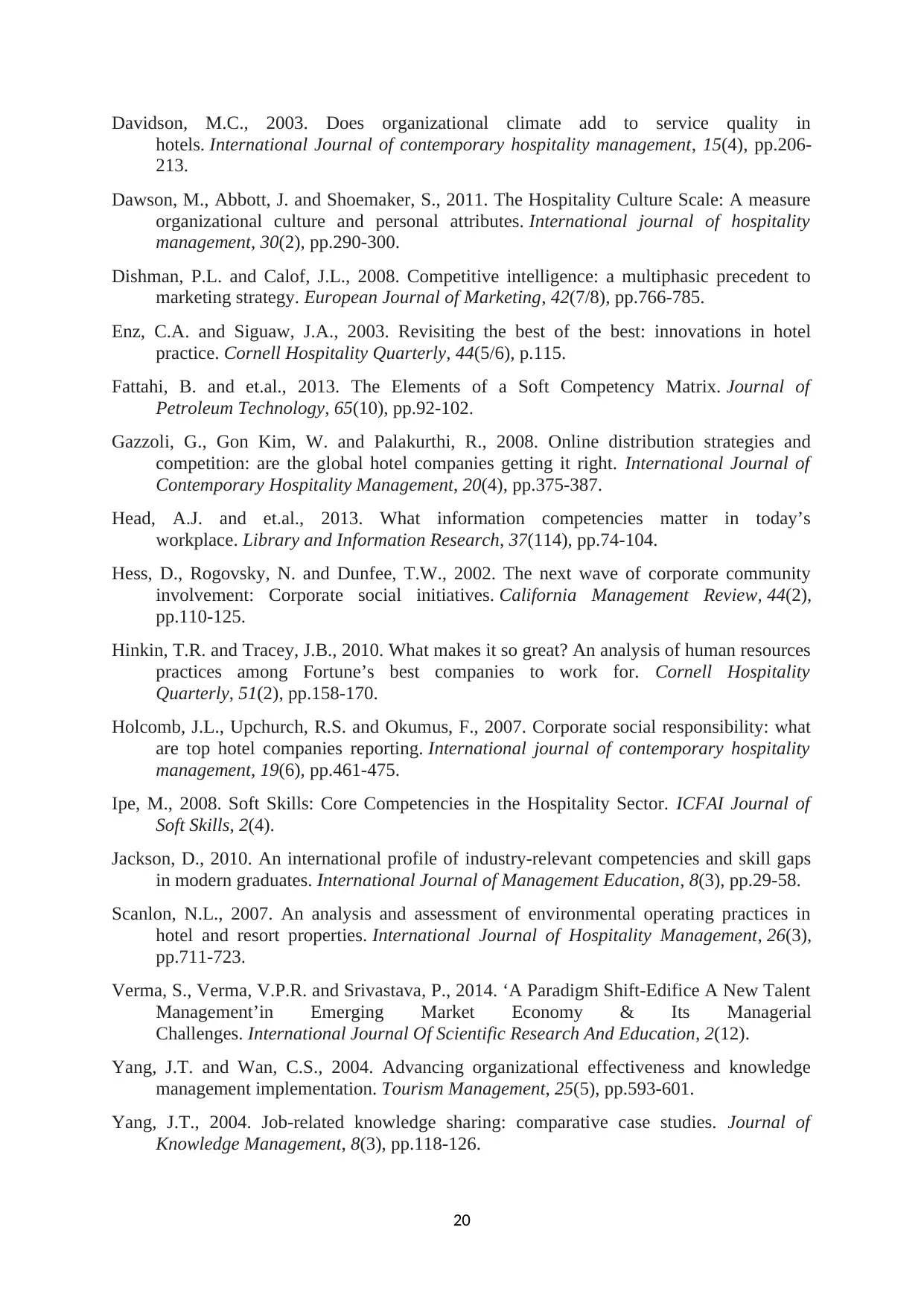
Davidson, M.C., 2003. Does organizational climate add to service quality in
hotels. International Journal of contemporary hospitality management, 15(4), pp.206-
213.
Dawson, M., Abbott, J. and Shoemaker, S., 2011. The Hospitality Culture Scale: A measure
organizational culture and personal attributes. International journal of hospitality
management, 30(2), pp.290-300.
Dishman, P.L. and Calof, J.L., 2008. Competitive intelligence: a multiphasic precedent to
marketing strategy. European Journal of Marketing, 42(7/8), pp.766-785.
Enz, C.A. and Siguaw, J.A., 2003. Revisiting the best of the best: innovations in hotel
practice. Cornell Hospitality Quarterly, 44(5/6), p.115.
Fattahi, B. and et.al., 2013. The Elements of a Soft Competency Matrix. Journal of
Petroleum Technology, 65(10), pp.92-102.
Gazzoli, G., Gon Kim, W. and Palakurthi, R., 2008. Online distribution strategies and
competition: are the global hotel companies getting it right. International Journal of
Contemporary Hospitality Management, 20(4), pp.375-387.
Head, A.J. and et.al., 2013. What information competencies matter in today’s
workplace. Library and Information Research, 37(114), pp.74-104.
Hess, D., Rogovsky, N. and Dunfee, T.W., 2002. The next wave of corporate community
involvement: Corporate social initiatives. California Management Review, 44(2),
pp.110-125.
Hinkin, T.R. and Tracey, J.B., 2010. What makes it so great? An analysis of human resources
practices among Fortune’s best companies to work for. Cornell Hospitality
Quarterly, 51(2), pp.158-170.
Holcomb, J.L., Upchurch, R.S. and Okumus, F., 2007. Corporate social responsibility: what
are top hotel companies reporting. International journal of contemporary hospitality
management, 19(6), pp.461-475.
Ipe, M., 2008. Soft Skills: Core Competencies in the Hospitality Sector. ICFAI Journal of
Soft Skills, 2(4).
Jackson, D., 2010. An international profile of industry-relevant competencies and skill gaps
in modern graduates. International Journal of Management Education, 8(3), pp.29-58.
Scanlon, N.L., 2007. An analysis and assessment of environmental operating practices in
hotel and resort properties. International Journal of Hospitality Management, 26(3),
pp.711-723.
Verma, S., Verma, V.P.R. and Srivastava, P., 2014. ‘A Paradigm Shift-Edifice A New Talent
Management’in Emerging Market Economy & Its Managerial
Challenges. International Journal Of Scientific Research And Education, 2(12).
Yang, J.T. and Wan, C.S., 2004. Advancing organizational effectiveness and knowledge
management implementation. Tourism Management, 25(5), pp.593-601.
Yang, J.T., 2004. Job-related knowledge sharing: comparative case studies. Journal of
Knowledge Management, 8(3), pp.118-126.
20
hotels. International Journal of contemporary hospitality management, 15(4), pp.206-
213.
Dawson, M., Abbott, J. and Shoemaker, S., 2011. The Hospitality Culture Scale: A measure
organizational culture and personal attributes. International journal of hospitality
management, 30(2), pp.290-300.
Dishman, P.L. and Calof, J.L., 2008. Competitive intelligence: a multiphasic precedent to
marketing strategy. European Journal of Marketing, 42(7/8), pp.766-785.
Enz, C.A. and Siguaw, J.A., 2003. Revisiting the best of the best: innovations in hotel
practice. Cornell Hospitality Quarterly, 44(5/6), p.115.
Fattahi, B. and et.al., 2013. The Elements of a Soft Competency Matrix. Journal of
Petroleum Technology, 65(10), pp.92-102.
Gazzoli, G., Gon Kim, W. and Palakurthi, R., 2008. Online distribution strategies and
competition: are the global hotel companies getting it right. International Journal of
Contemporary Hospitality Management, 20(4), pp.375-387.
Head, A.J. and et.al., 2013. What information competencies matter in today’s
workplace. Library and Information Research, 37(114), pp.74-104.
Hess, D., Rogovsky, N. and Dunfee, T.W., 2002. The next wave of corporate community
involvement: Corporate social initiatives. California Management Review, 44(2),
pp.110-125.
Hinkin, T.R. and Tracey, J.B., 2010. What makes it so great? An analysis of human resources
practices among Fortune’s best companies to work for. Cornell Hospitality
Quarterly, 51(2), pp.158-170.
Holcomb, J.L., Upchurch, R.S. and Okumus, F., 2007. Corporate social responsibility: what
are top hotel companies reporting. International journal of contemporary hospitality
management, 19(6), pp.461-475.
Ipe, M., 2008. Soft Skills: Core Competencies in the Hospitality Sector. ICFAI Journal of
Soft Skills, 2(4).
Jackson, D., 2010. An international profile of industry-relevant competencies and skill gaps
in modern graduates. International Journal of Management Education, 8(3), pp.29-58.
Scanlon, N.L., 2007. An analysis and assessment of environmental operating practices in
hotel and resort properties. International Journal of Hospitality Management, 26(3),
pp.711-723.
Verma, S., Verma, V.P.R. and Srivastava, P., 2014. ‘A Paradigm Shift-Edifice A New Talent
Management’in Emerging Market Economy & Its Managerial
Challenges. International Journal Of Scientific Research And Education, 2(12).
Yang, J.T. and Wan, C.S., 2004. Advancing organizational effectiveness and knowledge
management implementation. Tourism Management, 25(5), pp.593-601.
Yang, J.T., 2004. Job-related knowledge sharing: comparative case studies. Journal of
Knowledge Management, 8(3), pp.118-126.
20
Secure Best Marks with AI Grader
Need help grading? Try our AI Grader for instant feedback on your assignments.
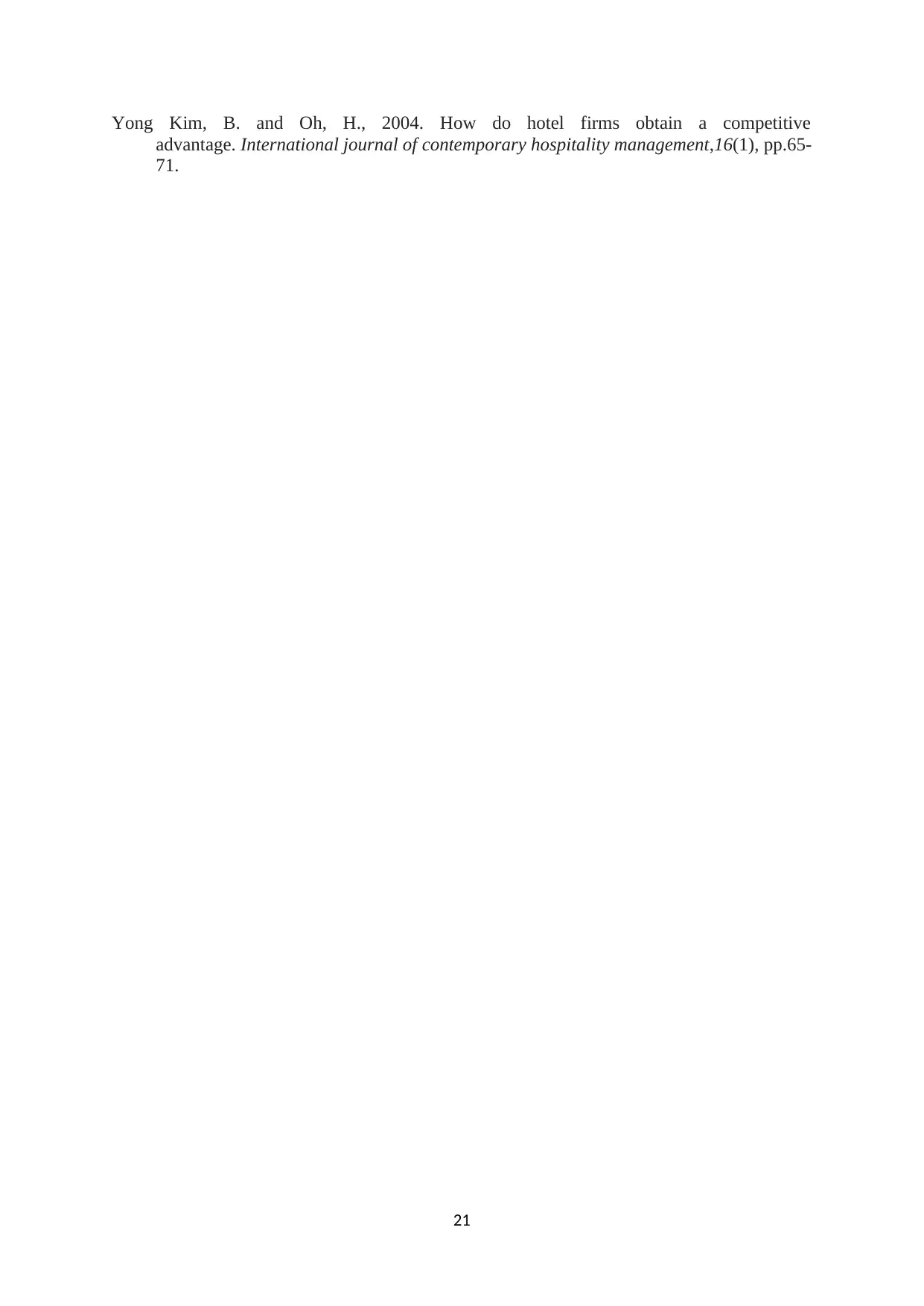
Yong Kim, B. and Oh, H., 2004. How do hotel firms obtain a competitive
advantage. International journal of contemporary hospitality management,16(1), pp.65-
71.
21
advantage. International journal of contemporary hospitality management,16(1), pp.65-
71.
21
1 out of 23
Related Documents
Your All-in-One AI-Powered Toolkit for Academic Success.
+13062052269
info@desklib.com
Available 24*7 on WhatsApp / Email
![[object Object]](/_next/static/media/star-bottom.7253800d.svg)
Unlock your academic potential
© 2024 | Zucol Services PVT LTD | All rights reserved.



